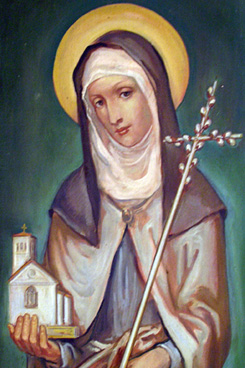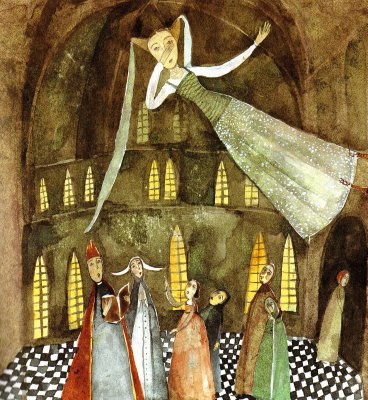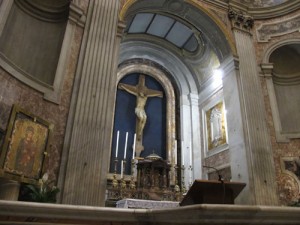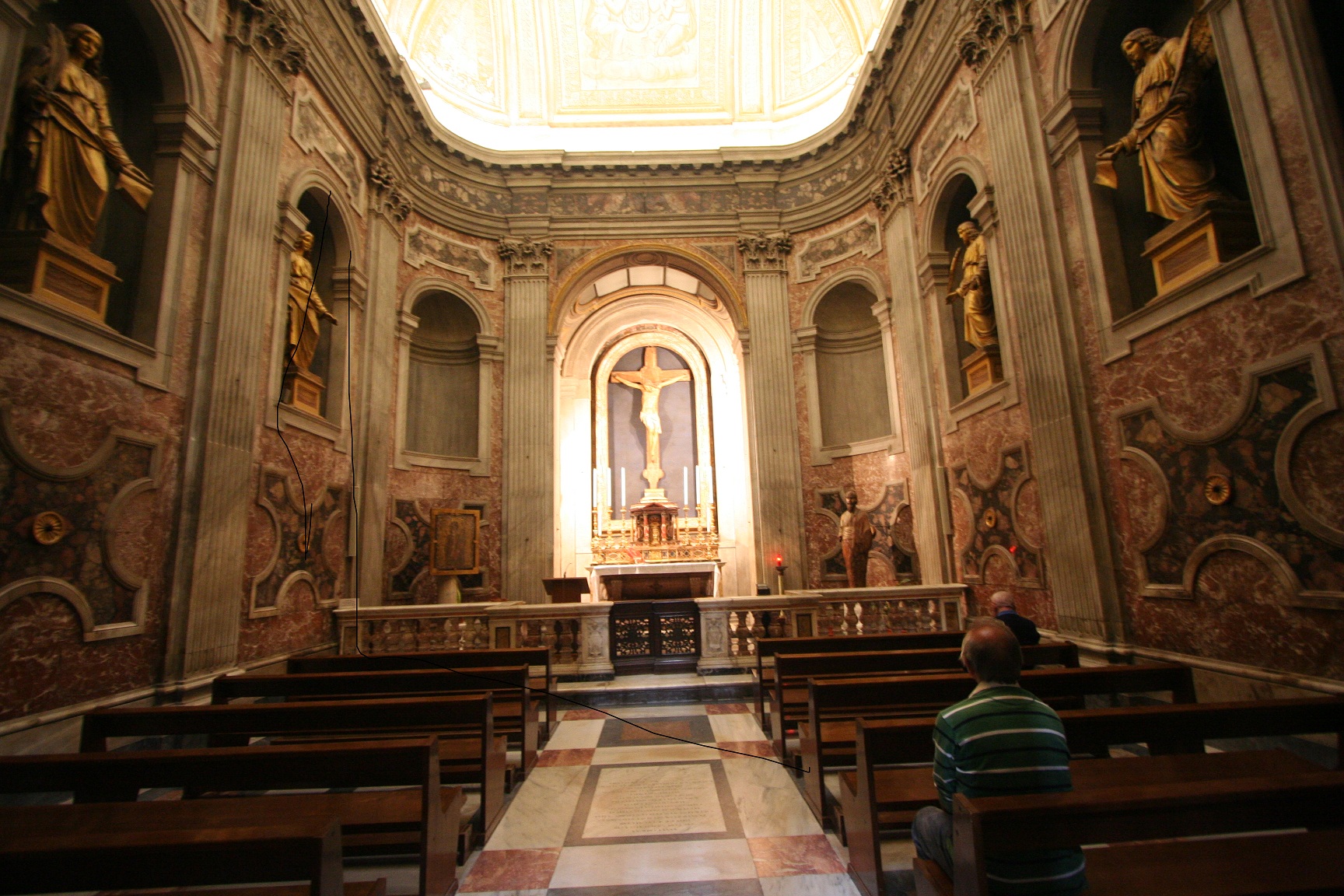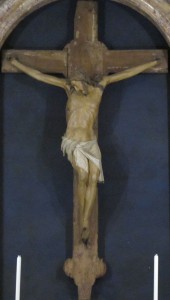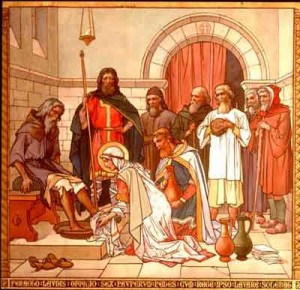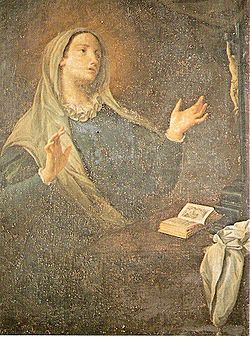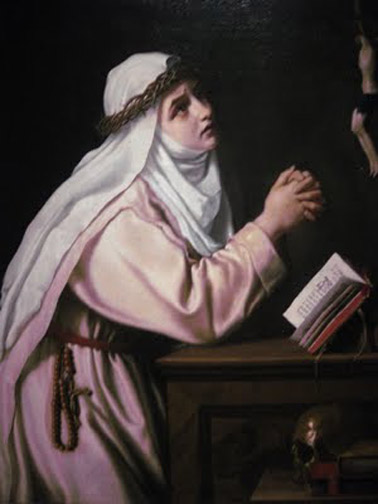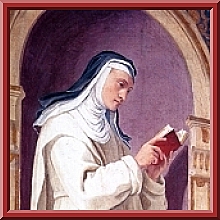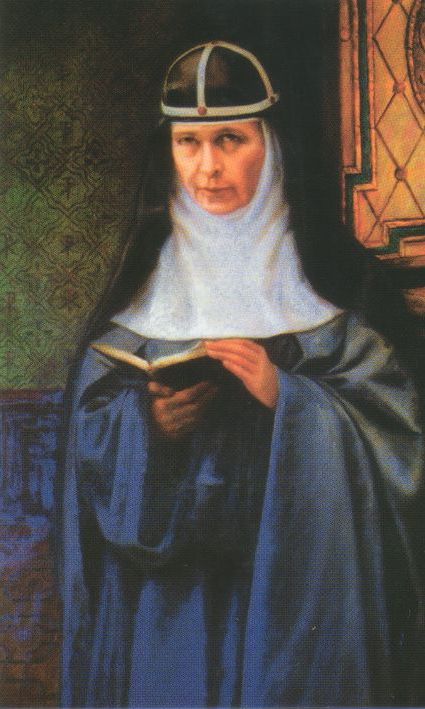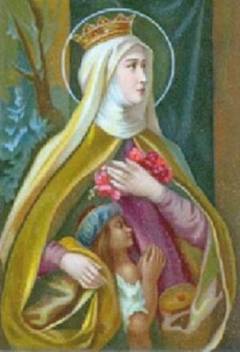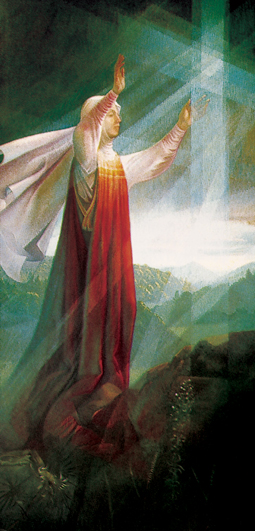Vatican City, Sep 15, 2010 Pope Benedict’s General Audience, from Vatican.va
Saint Clare of Assisi
Dear Brothers and Sisters,
One of the best loved Saints is without a doubt St Clare of Assisi who lived in the 13th century and was a contemporary of St Francis. Her testimony shows us how indebted the Church is to courageous women, full of faith like her, who can give a crucial impetus to the Church’s renewal.
So who was Clare of Assisi? To answer this question we possess reliable sources: not only the ancient biographies, such as that of Tommaso da Celano, but also the Proceedings of the cause of her canonization that the Pope promoted only a few month after Clare’s death and that contain the depositions of those who had lived a long time with her.
Born in 1193, Clare belonged to a wealthy, aristocratic family. She renounced her noble status and wealth to live in humility and poverty, adopting the lifestyle that Francis of Assisi recommended. Although her parents were planning a marriage for her with some important figure, as was then the custom, Clare, with a daring act inspired by her deep desire to follow Christ and her admiration for Francis, at the age of 18 left her family home and, in the company of a friend, Bona di Guelfuccio, made her way in secret to the Friars Minor at the little Church of the Portiuncula. It was the evening of Palm Sunday in 1211. In the general commotion, a highly symbolic act took place: while his companions lit torches, Francis cut off Clare’s hair and she put on a rough penitential habit. From that moment she had become the virgin bride of Christ, humble and poor, and she consecrated herself totally to him. Like Clare and her companions, down through history innumerable women have been fascinated by love for Christ which, with the beauty of his Divine Person, fills their hearts. And the entire Church, through the mystical nuptial vocation of consecrated virgins, appears what she will be for ever: the pure and beautiful Bride of Christ.
In one of the four letters that Clare sent to St Agnes of Prague the daughter of the King of Bohemia, who wished to follow in Christ’s footsteps, she speaks of Christ, her beloved Spouse, with nuptial words that may be surprising but are nevertheless moving: “When you have loved [him] you shall be chaste; when you have touched [him] you shall become purer; when you have accepted [him] you shall be a virgin. Whose power is stronger, whose generosity is more elevated, whose appearance more beautiful, whose love more tender, whose courtesy more gracious. In whose embrace you are already caught up; who has adorned your breast with precious stones… and placed on your head a golden crown as a sign [to all] of your holiness” (First Letter to Blessed Agnes of Prague: FF,2862).
Especially at the beginning of her religious experience, Francis of Assisi was not only a teacher to Clare whose teachings she was to follow but also a brotherly friend. The friendship between these two Saints is a very beautiful and important aspect.
Indeed, when two pure souls on fire with the same love for God meet, they find in their friendship with each other a powerful incentive to advance on the path of perfection. Friendship is one of the noblest and loftiest human sentiments which divine Grace purifies and transfigures.
Like St Francis and St Clare, other Saints too experienced profound friendship on the journey towards Christian perfection. Examples are St Francis de Sales and St Jane Frances de Chantal. And St Francis de Sales himself wrote: “It is a blessed thing to love on earth as we hope to love in Heaven, and to begin that friendship here which is to endure for ever there. I am not now speaking of simple charity, a love due to all mankind, but of that spiritual friendship which binds souls together, leading them to share devotions and spiritual interests, so as to have but one mind between them” (The Introduction to a Devout Life, III, 19).
After spending a period of several months at other monastic communities, resisting the pressure of her relatives who did not at first approve of her decision, Clare settled with her first companions at the Church of San Damiano where the Friars Minor had organized a small convent for them. She lived in this Monastery for more than 40 years, until her death in 1253. A first-hand description has come down to us of how these women lived in those years at the beginning of the Franciscan movement. It is the admiring account of Jacques de Vitry, a Flemish Bishop who came to Italy on a visit. He declared that he had encountered a large number of men and women of every social class who, having “left all things for Christ, fled the world. They called themselves Friars Minor and Sisters Minor [Lesser] and are held in high esteem by the Lord Pope and the Cardinals…. The women live together in various homes not far from the city. They receive nothing but live on the work of their own hands. And they are deeply troubled and pained at being honoured more than they would like to be by both clerics and lay people” (Letter of October 1216:Â FF, 2205, 2207).
Jacques de Vitry had perceptively noticed a characteristic trait of Franciscan spirituality about which Clare was deeply sensitive: the radicalism of poverty associated with total trust in Divine Providence. For this reason, she acted with great determination, obtaining from Pope Gregory IX or, probably, already from Pope Innocent III, the so-called Privilegium Paupertatis (cf. FF.,3279). On the basis of this privilege Clare and her companions at San Damiano could not possess any material property. This was a truly extraordinary exception in comparison with the canon law then in force but the ecclesiastical authorities of that time permitted it, appreciating the fruits of evangelical holiness that they recognized in the way of life of Clare and her sisters. This shows that even in the centuries of the Middle Ages the role of women was not secondary but on the contrary considerable. In this regard, it is useful to remember that Clare was the first woman in the Church’s history who composed a written Rule, submitted for the Pope’s approval, to ensure the preservation of Francis of Assisi’s charism in all the communities of women large numbers of which were already springing up in her time that wished to draw inspiration from the example of Francis and Clare.
In the Convent of San Damiano, Clare practised heroically the
virtues that should distinguish every Christian: humility, a spirit of piety and penitence and charity. Although she was the superior, she wanted to serve the sick sisters herself and joyfully subjected herself to the most menial tasks. In fact, charity overcomes all resistance and whoever loves, joyfully performs every sacrifice. Her faith in the Real Presence of Christ in the Eucharist was so great that twice a miracle happened. Simply by showing to them the Most Blessed Sacrament distanced the Saracen mercenaries, who were on the point of attacking the convent of San Damiano and pillaging the city of Assisi.
Such episodes, like other miracles whose memory lives on, prompted Pope Alexander IV to canonize her in 1255, only two years after her death, outlining her eulogy in the Bull on the Canonization of St Clare. In it we read: “How powerful was the illumination of this light and how strong the brightness of this source of light. Truly this light was kept hidden in the cloistered life; and outside them shone with gleaming rays; Clare in fact lay hidden, but her life was revealed to all. Clare was silent, but her fame was shouted out” (FF, 3284). And this is exactly how it was, dear friends: those who change the world for the better are holy, they transform it permanently, instilling in it the energies that only love inspired by the Gospel can elicit. The Saints are humanity’s great benefactors!
St Clare’s spirituality, the synthesis of the holiness she proposed is summed up in the fourth letter she wrote to St Agnes of Prague. St Clare used an image very widespread in the Middle Ages that dates back to Patristic times: the mirror. And she invited her friend in Prague to reflect herself in that mirror of the perfection of every virtue which is the Lord himself. She wrote: “Happy, indeed, is the one permitted to share in this sacred banquet so as to be joined with all the feelings of her heart (to Christ) whose beauty all the blessed hosts of the Heavens unceasingly admire, whose affection moves, whose contemplation invigorates, whose generosity fills, whose sweetness replenishes, whose remembrance pleasantly brings light, whose fragrance will revive the dead, and whose glorious vision will bless all the citizens of the heavenly Jerusalem, because the vision of him is thesplendour of everlasting glory, the radiance of everlasting light, and a mirror without tarnish. Look into this mirror every day, O Queen, spouse of Jesus Christ, and continually examine your face in it, so that in this way you may adorn yourself completely, inwardly and outwardly…. In this mirror shine blessed poverty, holy humility, and charity beyond words…” (Fourth Letter to Blessed Agnes of Prague, FF, 2901-2903).
Grateful to God who give us Saints who speak to our hearts and offer us an example of Christian life to imitate, I would like to end with the same words of Blessing that St Clare composed for her Sisters and which the Poor Clares, who play a precious role in the Church with their prayer and with their work, still preserve today with great devotion. These are words in which the full tenderness of her spiritual motherhood emerges: “I give you my blessing now while living, and after my death, in as far as I may: nay, even more than I may, I call down on you all the blessings that the Father of mercies has bestowed and continues to bestow on his spiritual sons and daughters both in Heaven and on earth, and with which a spiritual father and mother have blessed and will bless their spiritual sons and daughters. Amen” (FF, 2856).
Tags: catholic, catholic podcast, catholic prayer, cathollc spirituality, Clare of Assisi, pope benedict, pope benedict xvi, Saint Clare of Assisi, st clare of assisi, women of the middle ages
This entry was posted on Monday, August 11th, 2014 at 11:02 am
You can follow any responses to this entry through the RSS 2.0 feed.
A Prayer to St. Christina
[powerpress]
Today is the feast day of St. Christina the Astonishing. Why is she astonishing…well, if everyone thought you were dead and during the course of your funeral you shot up and proceeded to levitate to the rafters of the church, they’d probably call you astonishing too. Now I’ve been known to fly into a panic and fly into a rage, and I even fly to Costco for a good deal…but fly in church? Nope, not me. But all things are possible, with God. This is just one of the stories I read about her a long time ago in an old version of Bulter’s Lives of the Saints.  What else do we know:
After her death experience, she related that she had witnessed heaven, hell, and purgatory. It is written that she said “As soon as my soul was separated from my body it was received by angels who conducted it to a very gloomy place, entirely filled with souls” where the torments there that they endured “appeared so excessive” that it was “impossible to give an idea of their rigor.”
She continued,”I saw among them many of my acquaintances” and touched deeply by their sad condition asked if this was Hell, but was told that it was Purgatory. Her angel guides brought her to Hell where again she recognized those she had formerly known. Next she was transported to Heaven, “even to the Throne of Divine Majesty” where she was “regarded with a favorable eye” and she experienced extreme joy and these words were spoken to her, ” Assuredly, My dear daughter, you will one day be with Me. Now, however, I allow you to choose, either to remain with Me henceforth from this time, or to return again to earth to accomplish a mission of charity and suffering. In order to deliver from the flames of Purgatory those souls which have inspired you with so much compassion, you shall suffer for them upon earth: you shall endure great torments, without however dying from their effects. And not only will you relieve the departed, but the example which you will give to the living, and your continual suffering, will lead sinners to be converted and to expiate their crimes. After having ended this new life, you shall return here laden with merits.”
Christina, at hearing this and “seeing the great advantages for souls” without hesitation she agreed to return to life and arose that same moment. She told those around her that for the sole purpose of relief of the departed and conversion of sinners did she return and that none should be astonished at the penances that she would practice, nor the life that she would lead hence forth, she is quoted as saying, “It will be so extraordinary that nothing like it has ever been seen.” Making penances for the souls of Purgatory and Hell would henceforth become a major theme in her life.
As chronicled by her contemporaries, she threw herself into burning furnaces and there suffered great tortures for extended time uttering frightful cries, yet coming forth with no sign of burning upon her. In winter she would plunge into the frozen Meuse River for hours and days and weeks at a time all the while praying to God and imploring His Mercy. She allowed herself to be carried by the currents down river to the mill where the wheel “whirled her round in a manner frightful to behold” yet she had no dislocations or broken bones. She was chased by dogs that bit and tore her flesh. She ran from them into thickets of thorns, and though covered in blood she would return with no wound or scar.
Christina died in 1224 of natural causes, aged 74. – Wikipedia
After reading this, maybe you might want to, at least, pray with St. Christina the Astonishing, for the Poor Souls in Puragatory…click on this link to join in
Tags: angels, conversion, death experience, feast day, hell and purgatory, His Mercy, Meuse River, mission, saints, suffering, women of the middle ages
This entry was posted on Wednesday, July 24th, 2013 at 12:02 am
You can follow any responses to this entry through the RSS 2.0 feed.
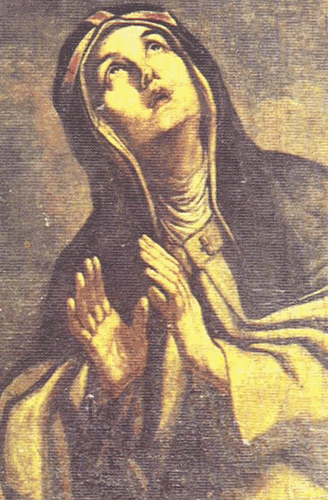 St. Bridget of Sweden…I never knew the power of the revelations to St. Bridget of Sweden until my friend Denise “reintroduced” them to me.  I say “reintroduced”, because I had bought the Pieta Prayer booklet (where they can be found) back in 1987. I offered them, really, only for a short while before packing the book away. But years later, after seeing how the revelations touched the heart of my
St. Bridget of Sweden…I never knew the power of the revelations to St. Bridget of Sweden until my friend Denise “reintroduced” them to me.  I say “reintroduced”, because I had bought the Pieta Prayer booklet (where they can be found) back in 1987. I offered them, really, only for a short while before packing the book away. But years later, after seeing how the revelations touched the heart of my dear friend, I dug the booklet out and started praying them again (as faithfully as I could). They are very powerful and beautiful. Meditating on the Passion of our Lord with the intensity called for in this particular devotion will change your life…are you ready?  How many of you out there have the Pieta prayer book and know the stories of St. Bridget of Sweden?
dear friend, I dug the booklet out and started praying them again (as faithfully as I could). They are very powerful and beautiful. Meditating on the Passion of our Lord with the intensity called for in this particular devotion will change your life…are you ready?  How many of you out there have the Pieta prayer book and know the stories of St. Bridget of Sweden?
(oh, be sure not to confuse her with St. Brigid of Kildare…it happens all the time)
Here  is the audio mp3 download of the 15 Prayers of St. Bridget as offered by Bruce McGregor and Denise Wharton
[powerpress ]
You can find the text for the prayers hereÂ
Here is the chapel in St. Paul’s Outside the Walls in Rome where St. Bridget received the private revelation of the 15 prayers…….
Of course, St. Bridget is more than just her prayers…ordinary woman, extraordinary life!. To learn more about St. Bridget of Sweden, take a look at this:
Tags: audio, feast day, Pieta Prayer, pieta prayer book, prayers, rome, st bridget of sweden, St. Paul Outside the Walls, Sweden, women of the middle ages
This entry was posted on Monday, July 23rd, 2012 at 1:00 am
You can follow any responses to this entry through the RSS 2.0 feed.
.
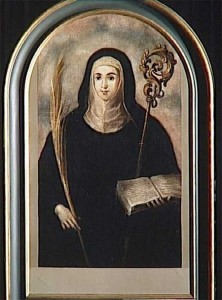 see also Pope Benedict’s teachings on St. Gertrude on the Discerning Hearts Holy Women page
see also Pope Benedict’s teachings on St. Gertrude on the Discerning Hearts Holy Women page
(1256-1302 A.D.) Few men have merited the title, “the Great”; fewer women. I know of only one nun so honored, St. Gertrude of Helfta, a mystic whose spiritual writings have remained influential up to the present.
Nothing is known of this German woman’s family background. When five years old, she was entrusted to the sisters of Helfta Abbey to be educated. From a very young age she gave evidence of her brilliance and quickly outstripped her companions. In her teen years she asked to join the community. Therefore, she probably spent her whole life from childhood on within the abbey walls.
Her love for secular studies made the common life wearisome, pride and vanity ate away at her soul and she soon became an unhappy young woman until Christ appeared to her. The day was branded in her memory, it was in her 26th year, when as she says “in a happy hour, at the beginning of twilight, thou O God of truth, more radiant than any light, yet deeper than any secret thing, determined to dissolve the obscurity of my darkness.” From then on her biographer tells us “she became a theologian instead of a grammarian.” She did not give up her intellectual ardor but now, all her labors were for her sisters, to cure what she termed “the wound of ignorance”. Her many gifts and mystical graces did not prevent her from giving herself wholeheartedly to the common life with its joys and sorrows. In fact many of her special graces came to her as she took part in the ordinary routine of convent life. She felt keenly for those whose burdens involved them in distracting duties, for example those responsible for meeting the debts of the monastery.
She prayed that they might have more time to pray and fewer distractions. The Lord’s answered “It does not matter to me whether you perform spiritual exercises or manual labor, provided only that your will is directed to me with a right intention. If I took pleasure only in your spiritual exercises, I should certainly have reformed human nature after Adam’s fall so that it would not need food, clothing or the other things that man must find or make with such effort.”
Many of her writings are lost, but fortunately she left to the world an abundance of spiritual joy in her book The Herald of Divine Love, in which she tells of the visions granted her by our divine Lord. She wrote this excellent, small book because she was told that nothing was given to her for her own sake only. Her Exercises is an excellent treatise on the renewal of baptismal vows, spiritual conversion, religious vows, love, praise, gratitude to God, reparation, and preparation for death.
She began to record her supernatural and mystical experiences in what eventually became her Book of Extraordinary Grace (Revelation of Saint Gertrude), together with Mechtilde’s mystical experiences Liber Specialis Gratiae, which Gertrude recorded. Most of the book was actually written by others based on Gertrude’s notes. She also wrote with or for Saint Mechtilde a series of prayers that became very popular, and through her writings helped spread devotion to the Sacred Heart (though it was not so called until revealed to St. Margaret Mary Alocoque).
Gertrude is inseparably associated with the devotion to the Sacred Heart. The pierced hear
t of Jesus embodied for her the Divine Love, an inexhaustible fountain of redemptive life. Her visions and insights in connection with the Heart of Jesus are very enlightening. In one such intellectual vision, she perceived the unceasing love of Christ for us in two pulsations of his Heart – one accomplished the conversion of sinners, the other the sanctification of the just. Just as our own faithful heart keeps right on whether we advert to it or not, these pulsations will endure till the end of time despite the vicissitudes of history.
Our Lord wishes people to pray for the souls in purgatory. He once showed Gertrude a table of gold on which were many costly pearls. The pearls were prayers for the holy souls. At the same time the saint had a vision of souls freed from suffering and ascending in the form of bright sparks to heaven.
In one Vision, Our Lord tells Gertrude that he longs for someone to ask Him to release souls from purgatory, just as a king who imprisons a friend for justice’s sake hopes that someone will beg for mercy for his friend. Jesus ends with:
“I accept with highest pleasure what is offered to Me for the poor souls, for I long inexpressibly to have near Me those for whom I paid so great a price. By the prayers of thy loving soul, I am induced to free a prisoner from purgatory as often as thou dost move thy tongue to utter a word of prayer.” (more…)
Tags: benedictine, catholic, catholic podcast, catholic prayer, cathollc spirituality, devotion, family, jesus christ, love, mystic of the Church, mystical experiences, sacred heart, sacred heart of jesus, spiritual exercises, spiritual writings, st gertrude, women of the middle ages
This entry was posted on Wednesday, November 16th, 2011 at 2:30 am
You can follow any responses to this entry through the RSS 2.0 feed.
A Queen of Scotland!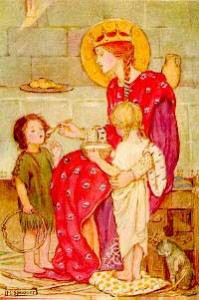
Margaret was born c. 1045 and was the niece of King Edward the Confessor of England. She was raised in Hungary and lived with her exiled father, Edward Atheling, her mother, Agatha, her brother, Edgar, and her sister, Christian. They returned to England in 1054. Early chronicles tell us that she read the scriptures in Latin, learned French and was trained in English needlework.
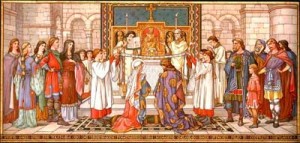 Marriage of St Margaret
Marriage of St MargaretMargaret married Malcolm III ‘Canmore’ of Scotland in c.1070. Margaret would have been about 24 years of age and Malcolm about 47. Ancient chronicles tell us that Margaret was more prepared for the cloister than the crown. However, Malcolm won her over and they were married in Dunfermline, then the seat of the Scottish kings.

Margaret had a significant influence on early Scotland. Although she was a patron of the existing celtic church, she also introduced to Scotland the Benedictines from Canterbury and had the Priory Church built which would eventually become Dunfermline Abbey. Margaret also had a chapel built at Edinburgh Castle and the church at Iona rebuilt after Viking attacks.
Washing the feet of the poor
Margaret was very pious and carried out many works of charity. She visited and cared for the sick and had hostels built for the poor. It was her custom that the poor should visit her every morning and be seated around her to receive alms. (more…)
Tags: benedictine, catholic, catholic podcast, catholic prayer, cathollc spirituality, celtic church, england, Malcolm III, mother, scotland, st margaret, St Margaret Margaret, St. Margaret of Scotland, women of the middle ages
This entry was posted on Wednesday, November 16th, 2011 at 12:04 am
You can follow any responses to this entry through the RSS 2.0 feed.
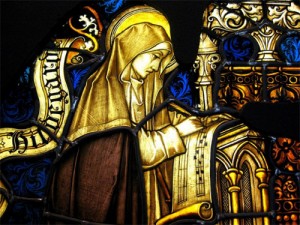 800+Â years later,
800+Â years later,
it still holds up….
now that’s the work of
the Holy Spirit!
Tags: catholic, catholic podcast, catholic prayer, cathollc spirituality, chant, mystic, mystic of the Church, st hildegard of bingen, st. hildegarde, women of the middle ages, work
This entry was posted on Saturday, September 17th, 2011 at 5:00 pm
You can follow any responses to this entry through the RSS 2.0 feed.
VATICAN CITY, 12 JAN 2011 (vatican.va) –
Dear Brothers and Sisters,
After Catherine of Siena and Catherine of Bologna, today I would like to speak to you about another Saint: Catherine of Genoa, known above all for her vision of purgatory. The text that describes her life and thought was published in this Ligurian city in 1551. It is in three sections: her Vita [Life], properly speaking, the Dimostratione et dechiaratione del purgatorio — better known as Treatise on purgatory — and her Dialogo tra l’anima e il corpo (cf. Libro de la Vita mirabile et dottrina santa, de la beata Caterinetta da Genoa. Nel quale si contiene una utile et catholica dimostratione et dechiaratione del purgatorio, Genoa 1551). The final version was written by Catherine’s confessor, Fr Cattaneo Marabotto.
Catherine was born in Genoa in 1447. She was the youngest of five. Her father, Giacomo Fieschi, died when she was very young. Her mother, Francesca di Negro provided such an effective Christian education that the elder of her two daughters became a religious.
When Catherine was 16, she was given in marriage to Giuliano Adorno, a man who after various trading and military experiences in the Middle East had returned to Genoa in order to marry.
Married life was far from easy for Catherine, partly because of the character of her husband who was given to gambling. Catherine herself was at first induced to lead a worldly sort of life in which, however, she failed to find serenity. After 10 years, her heart was heavy with a deep sense of emptiness and bitterness.
A unique experience on 20 March 1473 sparked her conversion. She had gone to the Church of San Benedetto in the monastery of Nostra Signora delle Grazie [Our Lady of Grace], to make her confession and, kneeling before the priest, “receivedâ€, as she herself wrote, “a wound in my heart from God’s immense loveâ€. It came with such a clear vision of her own wretchedness and shortcomings and at the same time of God’s goodness, that she almost fainted.
Her heart was moved by this knowledge of herself — knowledge of the empty life she was leading and of the goodness of God. This experience prompted the decision that gave direction to her whole life. She expressed it in the words: “no longer the world, no longer sin†(cf. Vita Mirabile, 3rv). Catherine did not stay to make her Confession.
On arriving home she entered the remotest room and spent a long time weeping. At that moment she received an inner instruction on prayer and became aware of God’s immense love for her, a sinner. It was a spiritual experience she had no words to  describe ( cf. Vita Mirabile, 4r).
It was on this occasion that the suffering Jesus appeared to her, bent beneath the Cross, as he is often portrayed in the Saint’s iconography. A few days later she returned to the priest to make a good confession at last. It was here that began the “life of purification†which for many years caused her to feel constant sorrow for the sins she had committed and which spurred her to impose forms of penance and sacrifice upon herself, in order to show her love to God.
On this journey Catherine became ever closer to the Lord until she attained what is called “unitive lifeâ€, namely, a relationship of profound union with God.
In her Vita it is written that her soul was guided and instructed from within solely by the sweet love of God which gave her all she needed. Catherine surrendered herself so totally into the hands of the Lord that she lived, for about 25 years, as she wrote, “without the assistance of any creature, taught and governed by God alone†(Vita, 117r-118r), nourished above all by constant prayer and by Holy Communion which she received every day, an unusual practice in her time. Only many years later did the Lord give her a priest who cared for her soul.
Catherine was always reluctant to confide and reveal her experience of mystical communion with God, especially because of the deep humility she felt before the Lord’s graces. The prospect of glorifying him and of being able to contribute to the spiritual journey of others alone spurred her to recount what had taken place within her, from the moment of her conversion, which is her original and fundamental experience.
The place of her ascent to mystical peaks was Pammatone Hospital, the largest hospital complex in Genoa, of which she was director and animator. Hence Catherine lived a totally active existence despite the depth of her inner life. In Pammatone a group of followers, disciples and collaborators formed around her, fascinated by her life of faith and her charity.
Indeed her husband, Giuliano Adorno, was so so won over that he gave up his dissipated life, became a Third Order Franciscan and moved into the hospital to help his wife.
Catherine’s dedication to caring for the sick continued until the end of her earthly life on 15 September 1510. From her conversion until her death there were no extraordinary events but two elements characterize her entire life: on the one hand her mystical experience, that is, the profound union with God, which she felt as spousal union, and on the other, assistance to the sick, the organization of the hospital and service to her neighbour, especially the neediest and the most forsaken. These two poles, God and neighbour, totally filled her life, virtually all of which she spent within the hospital walls.
Dear friends, we must never forget that the more we love God and the more constantly we pray, the better we will succeed in truly loving those who surround us, who are close to us, so that we can see in every person the Face of the Lord whose love knows no bounds and makes no distinctions. The mystic does not create distance from others or an abstract life, but rather approaches other people so that they may begin to see and act with God’s eyes and heart.
Catherine’s thought on purgatory, for which she is particularly well known, is summed up in the last two parts of the book mentioned above: The Treatise on purgatory and the Dialogues between the body and the soul. It is important to note that Catherine, in her mystical experience, never received specific revelations on purgatory or on the souls being purified there. Yet, in the writings inspired by our Saint, purgatory is a central element and the description of it has characteristics that were original in her time.
The first original passage concerns the “place†of the purification of souls. In her day it was depicted mainly using images linked to space: a certain space was conceived of in which purgatory was supposed to be located.
Catherine, however, did not see purgatory as a scene in the bowels of the earth: for her it is not an exterior but rather an interior fire. This is purgatory: an inner fire.
The Saint speaks of the Soul’s journey of purification on the way to full communion with God, starting from her own experience of profound sorrow for the sins committed, in comparison with God’s infinite love (cf. Vita Mirabile, 171v).
We heard of the moment of conversion when Catherine suddenly became aware of God’s goodness, of the infinite distance of her own life from this goodness and of a burning fire within her. And this is the fire that purifies, the interior fire of purgatory. Here too is an original feature in comparison with the thought of her time.
In fact, she does not start with the afterlife in order to recount the torments of purgatory — as was the custom in her time and perhaps still is today — and then to point out the way to purification or conversion. Rather our Saint begins with the inner experience of her own life on the way to Eternity.
“The soulâ€, Catherine says, “presents itself to God still bound to the desires and suffering that derive from sin and this makes it impossible for it to enjoy the beatific vision of Godâ€. Catherine asserts that God is so pure and holy that a soul stained by sin cannot be in the presence of the divine majesty (cf. Vita Mirabile, 177r).
We too feel how distant we are, how full we are of so many things that we cannot see God. The soul is aware of the immense love and perfect justice of God and consequently suffers for having failed to respond in a correct and perfect way to this love; and love for God itself becomes a flame, love itself cleanses it from the residue of sin.
In Catherine we can make out the presence of theological and mystical sources on which it was normal to draw in her time. In particular, we find an image typical of Dionysius the Areopagite: the thread of gold that links the human heart to God himself. When God purified man, he bound him with the finest golden thread, that is, his love, and draws him toward himself with such strong affection that man is as it were “overcome and won over and completely beside himselfâ€.
Thus man’s heart is pervaded by God’s love that becomes the one guide, the one driving force of his life (cf. Vita Mirabile, 246rv). This situation of being uplifted towards God and of surrender to his will, expressed in the image of the thread, is used by Catherine to express the action of divine light on the souls in purgatory, a light that purifies and raises them to the splendour of the shining radiance of God (cf. Vita Mirabile, 179r).
Dear friends, in their experience of union with God, Saints attain such a profound knowledge of the divine mysteries in which love and knowledge interpenetrate, that they are of help to theologians themselves in their commitment to study, to intelligentia fidei, to an intelligentia of the mysteries of faith, to attain a really deeper knowledge of the mysteries of faith, for example, of what purgatory is.
With her life St Catherine teaches us that the more we love God and enter into intimacy with him in prayer the more he makes himself known to us, setting our hearts on fire with his love.
In writing about purgatory, the Saint reminds us of a fundamental truth of faith that becomes for us an invitation to pray for the deceased so that they may attain the beatific vision of God in the Communion of Saints (cf. Catechism of the Catholic Church, n. 1032).
Moreover the humble, faithful and generous service in Pammatone Hospital that the Saint rendered throughout her life is a shining example of charity for all and an encouragement, especially for women who, with their precious work enriched by their sensitivity and attention to the poorest and neediest, make a fundamental contribution to society and to the Church. Many thanks.
For more on St. Catherine of Genoa visit Discerning Hearts post St. Catherine of Genoa…it’s all about Divine Love
Tags: benedict xvi, Catherine of Genoa, catholic, catholic podcast, catholic prayer, cathollc spirituality, experience, love, mystic, mystic of the Church, mystical communion, mystical experience, purgatory, relationship, souls in purgatory, st catherine of genoa, Vita Mirabile, women of the middle ages
This entry was posted on Wednesday, January 12th, 2011 at 1:01 pm
You can follow any responses to this entry through the RSS 2.0 feed.
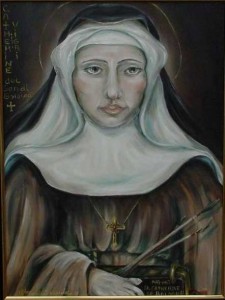 Patroness of Artists and Against Spiritual Temptation
Patroness of Artists and Against Spiritual Temptation
VATICAN CITY, 29 DEC 2010 (vatican.va) –
Dear Brothers and Sisters,
In a recent Catechesis I spoke of St Catherine of Siena. Today I would like to present to you another less well known Saint who has the same name: St Catherine of Bologna, a very erudite yet very humble woman. She was dedicated to prayer but was always ready to serve; generous in sacrifice but full of joy in welcoming Christ with the Cross. Catherine was born in Bologna on 8 September 1413, the eldest child of Benvenuta Mammolini and John de’ Vigri, a rich and cultured patrician of Ferrara, a doctor in law and a public lector in Padua, where he carried out diplomatic missions for Nicholas III d’Este, Marquis of Ferrara.
Not much information about Catherine’s infancy and childhood is available and not all of it is reliable. As a child she lived in her grandparents’ house in Bologna, where she was brought up by relatives, especially by her mother who was a woman of deep faith. With her, Catherine moved to Ferrara when she was about 10 years old and entered the court of Nicholas III d’Este as lady-in-waiting to Margaret, Nicholas’ illegitimate daughter. The Marquis was transforming Ferrara into a fine city, summoning artists and scholars from various countries. He encouraged culture and, although his private life was not exemplary, took great care of the spiritual good, moral conduct and education of his subjects. In Ferrara Catherine was unaware of the negative aspects that are often part and parcel of court life. She enjoyed Margaret’s friendship and became her confidante. She developed her culture by studying music, painting and dancing; she learned to write poetry and literary compositions and to play the viola; she became expert in the art of miniature-painting and copying; she perfected her knowledge of Latin. In her future monastic life she was to put to good use the cultural and artistic heritage she had acquired in these years. She learned with ease, enthusiasm and tenacity. She showed great prudence, as well as an unusual modesty, grace and kindness in her behaviour. However, one absolutely clear trait distinguished her: her spirit, constantly focused on the things of Heaven. In 1427, when she was only 14 years old and subsequent to certain family events, Catherine decided to leave the court to join a group of young noble women who lived a community life dedicating themselves to God. Her mother trustingly consented in spite of having other plans for her daughter. We know nothing of Catherine’s spiritual path prior to this decision. Speaking in the third person, she states that she entered God’s service, “illumined by divine grace… with an upright conscience and great fervourâ€, attentive to holy prayer by night and by day, striving to acquire all the virtues she saw in others, “not out of envy but the better to please God in whom she had placed all her love†(Le sette armi necessarie alla battaglia spirituali, [The seven spiritual weapons], VII, 8, Bologna 1998, p. 12). She made considerable spiritual progress in this new phase of her life but her trials, her inner suffering and especially the temptations of the devil were great and terrible. She passed through a profound spiritual crisis and came to the brink of despair (cf. ibid., VII, 2, pp. 12-29). She lived in the night of the spirit, and was also deeply shaken by the temptation of disbelief in the Eucharist.
After so much suffering, the Lord comforted her: he gave her, in a vision, a clear awareness of the Real Presence in the Eucharist, an awareness so dazzling that Catherine was unable to express it in words (cf. ibid., VIII, 2. pp. 42-46).
In this same period a sorrowful trial afflicted the community: tension arose between those who wished to follow the Augustinian spirituality and those who had more of an inclination for Franciscan spirituality. Between 1429 and 1430, Lucia Mascheroni, in charge of the group, decided to found an Augustinian monastery. Catherine, on the other hand chose with others to bind herself to the Rule of St Clare of Assisi. It was a gift of Providence, because the community dwelled in the vicinity of the Church of the Holy Spirit, annexed to the convent of the Friars Minor who had adhered to the movement of the Observance. Thus Catherine and her companions could take part regularly in liturgical celebrations and receive adequate spiritual assistance. They also had the joy of listening to the preaching of St Bernardine of Siena (cf. ibid., VII, 62, p. 26). Catherine recounts that in 1429 — the third year since her conversion — she went to make her confession to one of the Friars Minor whom she esteemed, she made a good Confession and prayed the Lord intensely to grant her forgiveness for all her sins and the suffering connected with them.
In a vision God revealed to her that he had forgiven her everything. It was a very strong experience of divine mercy which left an indelible mark upon her, giving her a fresh impetus to respond generously to God’s immense love (cf. ibid. IX, 2, pp. 46-48).
In 1431 she had a vision of the Last Judgement. The terrifying spectacle of the damned impelled her to redouble her prayers and penance for the salvation of sinners. The devil continued to assail her and she entrusted herself ever more totally to the Lord and to the Virgin Mary (cf. ibid., X, 3, pp. 53-54). In her writings, Catherine has left us a few essential notes concerning this mysterious battle from which, with God’s grace, she emerged victorious. She did so in order to instruct her sisters and those who intend to set out on the path of perfection: she wanted to put them on their guard against the temptations of the devil who often conceals himself behind deceptive guises, later to sow doubts about faith, vocational uncertainty and sensuality. In her autobiographical and didactic treatise, The Seven Spiritual Weapons, Catherine offers in this regard teaching of deep wisdom and profound discernment. She speaks in the third person in reporting the extraordinary graces which the Lord gives to her and in the first person in confessing her sins. From her writing transpires the purity of her faith in God, her profound humility, the simplicity of her heart, her missionary zeal, her passion for the salvation of souls. She identifies seven weapons in the fight against evil, against the devil:
1. always to be careful and diligently strive to do good;
2. to believe that alone we will never be able to do something truly good;
3. to trust in God and, for love of him, never to fear in the battle against evil, either in the world or within ourselves;
4. to meditate often on the events and words of the life of Jesus, and especially on his Passion and his death;
5. to remember that we must die;
6. to focus our minds firmly on memory of the goods of Heaven;
7. to be familiar with Sacred Scripture, always cherishing it in our hearts so that it may give direction to all our thoughts and all our actions.
A splendid programme of spiritual life, today too, for each one of us!
In the convent Catherine, in spite of being accustomed to the court in Ferrara, served in the offices of laundress, dressmaker and breadmaker and even looked after the animals. She did everything, even the lowliest tasks, with love and ready obedience, offering her sisters a luminous witness. Indeed she saw disobedience as that spiritual pride which destroys every other virtue. Out of obedience she accepted the office of novice mistress, although she considered herself unfit for this office, and God continued to inspire her with his presence and his gifts: in fact she proved to be a wise and appreciated mistress. Later the service of the parlour was entrusted to her. She found it trying to have to interrupt her prayers frequently in order to respond to those who came to the monastery grill, but this time too the Lord did not fail to visit her and to be close to her. With her the monastery became an increasingly prayerful place of self-giving, of silence, of endeavour and of joy. Upon the death of the abbess, the superiors thought immediately of her, but Catherine urged them to turn to the Poor Clares of Mantua who were better instructed in the Constitutions and in religious observance. Nevertheless, a few years later, in 1456, she was asked at her monastery to open a new foundation in Bologna. Catherine would have preferred to end her days in Ferrara, but the Lord appeared to her and exhorted her to do God’s will by going to Bologna as abbess. She prepared herself for the new commitment with fasting, scourging and penance. She went to Bologna with 18 sisters. As superior she set the example in prayer and in service; she lived in deep humility and poverty. At the end of her three-year term as abbess she was glad to be replaced but after a year she was obliged to resume her office because the newly elected abbess became blind. Although she was suffering and and was afflicted with serious ailments that tormented her, she carried out her service with generosity and dedication. For another year she urged her sisters to an evangelical life, to patience and constancy in trial, to fraternal love, to union with the divine Bridegroom, Jesus, so as to prepare her dowry for the eternal nuptials. It was a dowry that Catherine saw as knowing how to share the sufferings of Christ, serenely facing hardship, apprehension, contempt and misunderstanding (cf. Le sette armi spirituali, X, 20, pp. 57-58). At the beginning of 1463 her health deteriorated. For the last time she gathered the sisters in Chapter, to announce her death to them and to recommend the observance of the Rule. Towards the end of February she was harrowed by terrible suffering that was never to leave her, yet despite her pain it was she who comforted her sisters, assuring them that she would also help them from Heaven. After receiving the last Sacraments, she give her confessor the text she had written: The Seven Spiritual Weapons, and entered her agony; her face grew beautiful and translucent; she still looked lovingly at those who surrounded her and died gently, repeating three times the name of Jesus. It was 9 March 1463 (cf. I. Bembo, Specchio di illuminazione, Vita di S. Caterina a Bologna,Florence 2001, chap. III). Catherine was to be canonized by Pope Clement XI on 22 May 1712. Her incorrupt body is preserved in the city of Bologna, in the chapel of the monastery of Corpus Domini. Dear friends, with her words and with her life, St Catherine of Bologna is a pressing invitation to let ourselves always be guided by God, to do his will daily, even if it often does not correspond with our plans, to trust in his Providence which never leaves us on our own. In this perspective, St Catherine speaks to us; from the distance of so many centuries she is still very modern and speaks to our lives.
She, like us, suffered temptations, she suffered the temptations of disbelief, of sensuality, of a difficult spiritual struggle. She felt forsaken by God, she found herself in the darkness of faith. Yet in all these situations she was always holding the Lord’s hand, she did not leave him, she did not abandon him. And walking hand in hand with the Lord, she walked on the right path and found the way of light.
So it is that she also tells us: take heart, even in the night of faith, even amidst our many doubts, do not let go of the Lord’s hand, walk hand in hand with him, believe in God’s goodness. This is how to follow the right path!
And I would like to stress another aspect: her great humility. She was a person who did not want to be someone or something; she did not care for appearances, she did not want to govern. She wanted to serve, to do God’s will, to be at the service of others. And for this very reason Catherine was credible in her authority, because she was able to see that for her authority meant, precisely, serving others.
Let us ask God, through the intercession of Our Saint, for the gift to achieve courageously and generously the project he has for us, so that he alone may be the firm rock on which our lives are built. Thank you.
Tags: Bologna, catholic, catholic podcast, catholic prayer, cathollc spirituality, evil, faith, franciscan spirituality, mystic of the Church, poor clares, pope benedict xvi, Saint Catherine, spiritual weapons, st catherine of bologna, suffering, temptations, women of the middle ages
This entry was posted on Thursday, December 30th, 2010 at 5:53 am
You can follow any responses to this entry through the RSS 2.0 feed.
“God’s Promises Are Always Greater Than Our Hopes”
VATICAN CITY, DEC. 1, 2010 (vatican.va).- Here is a translation of the address Benedict XVI gave today during the general audience in Paul VI Hall.
Dear Brothers and Sisters,
I still remember with great joy the Apostolic Journey I made in the United Kingdom last September. England is a land that has given birth to a great many distinguished figures who enhanced Church history with their testimony and their teaching. One of them, venerated both in the Catholic Church and in the Anglican Communion, is the mystic Julian of Norwich, of whom I wish to speak this morning.
The — very scant — information on her life in our possession comes mainly from her Revelations of Divine Love in Sixteen Showings, the book in which this kindly and devout woman set down the content of her visions.
It is known that she lived from 1342 until about 1430, turbulent years both for the Church, torn by the schism that followed the Pope’s return to Rome from Avignon, and for the life of the people who were suffering the consequences of a long drawn-out war between the Kingdoms of England and of France. God, however, even in periods of tribulation, does not cease to inspire figures such as Julian of Norwich, to recall people to peace, love and joy.
As Julian herself recounts, in May 1373, most likely on the 13th of that month, she was suddenly stricken with a very serious illness that in three days seemed to be carrying her to the grave. After the priest, who hastened to her bedside, had shown her the Crucified One not only did Julian rapidly recover her health but she received the 16 revelations that she subsequently wrote down and commented on in her book, Revelations of Divine Love.
And it was the Lord himself, 15 years after these extraordinary events, who revealed to
her the meaning of those visions.
“‘Would you learn to see clearly your Lord’s meaning in this thing? Learn it well: Love was his meaning. Who showed it to you? Love…. Why did he show it to you? For Love’…. Thus I was taught that Love was our Lord’s meaning†(Julian of Norwich, Revelations of Divine Love,Chapter 86).
Inspired by divine love, Julian made a radical decision. Like an ancient anchoress, she decided to live in a cell located near the church called after St Julian, in the city of Norwich — in her time an important urban centre not far from London.
She may have taken the name of Julian precisely from that Saint to whom was dedicated the church in whose vicinity she lived for so many years, until her death.
This decision to live as a “recluseâ€, the term in her day, might surprise or even perplex us. But she was not the only one to make such a choice. In those centuries a considerable number of women opted for this form of life, adopting rules specially drawn up, for them, such as the rule compiled by St Aelred of Rievaulx.
The anchoresses or “reclusesâ€, in their cells, devoted themselves to prayer, meditation and study. In this way they developed a highly refined human and religious sensitivity which earned them the veneration of the people. Men and women of every age and condition in need of advice and comfort, would devoutly seek them. It was not, therefore, an individualistic choice; precisely with this closeness to the Lord, Julian developed the ability to be a counsellor to a great many people and to help those who were going through difficulties in this life.
We also know that Julian too received frequent visitors, as is attested by the autobiography of another fervent Christian of her time, Margery Kempe, who went to Norwich in 1413 to receive advice on her spiritual life. This is why, in her lifetime, Julian was called “Dame Julianâ€, as is engraved on the funeral monument that contains her remains. She had become a mother to many.
Men and women who withdraw to live in God’s company acquire by making this decision a great sense of compassion for the suffering and weakness of others. As friends of God, they have at their disposal a wisdom that the world — from which they have distanced themselves — does not possess and they amiably share it with those who knock at their door.
I therefore recall with admiration and gratitude the women and men’s cloistered monasteries. Today more than ever they are oases of peace and hope, a precious treasure for the whole Church, especially since they recall the primacy of God and the importance, for the journey of faith, of constant and intense prayer.
It was precisely in the solitude infused with God that Julian of Norwich wrote her Revelations of Divine Love. Two versions have come down to us, one that is shorter, probably the older, and one that is longer. This book contains a message of optimism based on the certainty of being loved by God and of being protected by his Providence.
In this book we read the following wonderful words: “And I saw full surely that ere God made us he loved us; which love was never lacking nor ever shall be. And in this love he has made all his works; and in this love he has made all things profitable to us; and in this love our life is everlasting… in which love we have our beginning. And all this shall we see in God, without end†(Revelations of Divine Love, Chapter 86).
The theme of divine love recurs frequently in the visions of Julian of Norwich who, with a certain daring, did not hesitate to compare them also to motherly love. This is one of the most characteristic messages of her mystical theology.
The tenderness, concern and gentleness of God’s kindness to us are so great that they remind us, pilgrims on earth, of a mother’s love for her children. In fact the biblical prophets also sometimes used this language that calls to mind the tenderness, intensity and totality of God’s love, which is manifested in creation and in the whole history of salvation that is crowned by the Incarnation of the Son.
God, however, always excels all human love, as the Prophet Isaiah says: “Can a woman forget her sucking child, that she should have no compassion on the son of her womb? Even these may forget, yet I will never forget you†(Is 49:15).
Julian of Norwich understood the central message for spiritual life:
God is love and it is only if one opens oneself to this love, totally and with total trust, and lets it become one’s sole guide in life, that all things are transfigured, true peace and true joy found and one is able to radiate it.
I would like to emphasize another point. The Catechism of the Catholic Church cites the words of Julian of Norwich when it explains the viewpoint of the Catholic faith on an argument that never ceases to be a provocation to all believers (cf. nn. 304-313, 314).
If God is supremely good and wise, why do evil and the suffering of innocents exist? And the Saints themselves asked this very question. Illumined by faith, they give an answer that opens our hearts to trust and hope: in the mysterious designs of Providence, God can draw a greater good even from evil, as Julian of Norwich wrote: “Here I was taught by the grace of God that I should steadfastly hold me in the Faith … and that … I should take my stand on and earnestly believe in … that ‘all manner of thing shall be wellâ€â€™ (The Revelations of Divine Love, Chapter 32).
Yes, dear brothers and sisters, God’s promises are ever greater than our expectations. If we present to God, to his immense love, the purest and deepest desires of our heart, we shall never be disappointed. “And all will be wellâ€, “all manner of things shall be wellâ€: this is the final message that Julian of Norwich transmits to us and that I am also proposing to you today. Many thanks.
Tags: anglican communion, benedict xvi, catholic, catholic podcast, catholic prayer, cathollc spirituality, julian of norwich, mystic, mystic of the Church, mystical experiences, Norwich, women of the middle ages
This entry was posted on Wednesday, December 1st, 2010 at 7:04 pm
You can follow any responses to this entry through the RSS 2.0 feed.
Vatican City –From Pope Benedict’s Wednesday General Audience from vatican.va
Dear Brothers and Sisters,
Today I would like to talk to you about a woman who played an eminent role in the history of the Church: St Catherine of Siena. The century in which she lived — the 14th — was a troubled period in the life of the Church and throughout the social context of Italy and Europe. Yet, even in the most difficult times, the Lord does not cease to bless his People, bringing forth Saints who give a jolt to minds and hearts, provoking conversion and renewal.
Catherine is one of these and still today speaks to us and impels us to walk courageously toward holiness to be ever more fully disciples of the Lord.
Born in Siena in 1347, into a very large family, she died in Rome in 1380. When Catherine was 16 years old, motivated by a vision of St Dominic, she entered the Third Order of the Dominicans, the female branch known as the Mantellate. While living at home, she confirmed her vow of virginity made privately when she was still an adolescent and dedicated herself to prayer, penance and works of charity, especially for the benefit of the sick.
When the fame of her holiness spread, she became the protagonist of an intense activity of spiritual
guidance for people from every walk of life: nobles and politicians, artists and ordinary people, consecrated men and women and religious, including Pope Gregory xi who was living at Avignon in that period and whom she energetically and effectively urged to return to Rome.
She travelled widely to press for the internal reform of the Church and to foster peace among the States. It was also for this reason that Venerable Pope John Paul ii chose to declare her Co-Patroness of Europe: may the Old Continent never forget the Christian roots that are at the origin of its progress and continue to draw from the Gospel the fundamental values that assure justice and harmony.
Like many of the Saints, Catherine knew great suffering. Some even thought that they should not trust her, to the point that in 1374, six years before her death, the General Chapter of the Dominicans summoned her to Florence to interrogate her. They appointed Raymund of Capua, a learned and humble Friar and a future Master General of the Order, as her spiritual guide. Having become her confessor and also her “spiritual sonâ€, he wrote a first complete biography of the Saint. She was canonized in 1461.
The teaching of Catherine, who learned to read with difficulty and learned to write in adulthood, is contained in the Dialogue of Divine Providence or Libro della Divina Dottrina, a masterpiece of spiritual literature, in her Epistolario and in the collection of her Prayers.
Her teaching is endowed with such excellence that in 1970 the Servant of God Paul VI declared her a Doctor of the Church, a title that was added to those of Co-Patroness of the City of Rome — at the wish of Bl. Pius ix — and of Patroness of Italy — in accordance with the decision of Venerable Pius XII.
In a vision that was ever present in Catherine’s heart and mind Our Lady presented her to Jesus who gave her a splendid ring, saying to her: “I, your Creator and Saviour, espouse you in the faith, that you will keep ever pure until you celebrate your eternal nuptials with me in Heaven†(Bl. Raimondo da Capua, S. Caterina da Siena, Legenda maior, n. 115, Siena 1998). This ring was visible to her alone. In this extraordinary episode we see the vital centre of Catherine’s religious sense, and of all authentic spirituality: Christocentrism. For her Christ was like the spouse with whom a relationship of intimacy, communion and faithfulness exists; he was the best beloved whom she loved above any other good. This profound union with the Lord is illustrated by another episode in the life of this outstanding mystic: the exchange of hearts. According to Raymond of Capua who passed on the confidences Catherine received, the Lord Jesus appeared to her “holding in his holy hands a human heart, bright red and shiningâ€. He opened her side and put the heart within her saying: “Dearest daughter, as I took your heart away from you the other day, now, you see, I am giving you mine, so that you can go on living with it for ever†(ibid.). Catherine truly lived St. Paul’s words, “It is no longer I who live, but Christ who lives in me†(Gal 2:20).
Like the Sienese Saint, every believer feels the need to be conformed with the sentiments of the heart of Christ to love God and his neighbour as Christ himself loves. And we can all let our hearts be transformed and learn to love like Christ in a familiarity with him that is nourished by prayer, by meditation on the Word of God and by the sacraments, above all by receiving Holy Communion frequently and with devotion. Catherine also belongs to the throng of Saints devoted to the Eucharist with which I concluded my Apostolic Exhortation Sacramentum Caritatis (cf. n. 94). Dear brothers and sisters, the Eucharist is an extraordinary gift of love that God continually renews to nourish our journey of faith, to strengthen our hope and to inflame our charity, to make us more and more like him.
A true and authentic spiritual family was built up around such a strong and genuine personality; people fascinated by the moral authority of this young woman with a most exalted lifestyle were at times also impressed by the mystical phenomena they witnessed, such as her frequent ecstasies. Many put themselves at Catherine’s service and above all considered it a privilege to receive spiritual guidance from her. They called her “mother†because, as her spiritual children, they drew spiritual nourishment from her. Today too the
Church receives great benefit from the exercise of spiritual motherhood by so many women, lay and consecrated, who nourish souls with thoughts of God, who strengthen the people’s faith and direct Christian life towards ever loftier peaks. “Son, I say to you and call youâ€, Catherine wrote to one of her spiritual sons, Giovanni Sabbatini, a Carthusian, “inasmuch as I give birth to you in continuous prayers and desire in the presence of God, just as a mother gives birth to a son†(Epistolario, Lettera n. 141: To Fr Giovanni de’ Sabbatini). She would usually address the Dominican Fr Bartolomeo de Dominici with these words: “Most beloved and very dear brother and son in Christ sweet Jesusâ€.
Another trait of Catherine’s spirituality is linked to the gift of tears. They express an exquisite, profound sensitivity, a capacity for being moved and for tenderness. Many Saints have had the gift of tears, renewing the emotion of Jesus himself who did not hold back or hide his tears at the tomb of his friend Lazarus and at the grief of Mary and Martha or at the sight of Jerusalem during his last days on this earth. According to Catherine, the tears of Saints are mingled with the blood of Christ, of which she spoke in vibrant tones and with symbolic images that were very effective: “Remember Christ crucified, God and man….. Make your aim the Crucified Christ, hide in the wounds of the Crucified Christ and drown in the blood of the Crucified Christ†(Epistolario, Lettera n. 21: Ad uno il cui nome si tace [to one who remains anonymous]). Here we can understand why, despite her awareness of the human shortcomings of priests, Catherine always felt very great reverence for them: through the sacraments and the word they dispense the saving power of Christ’s Blood. The Sienese Saint always invited the sacred ministers, including the Pope whom she called “sweet Christ on earthâ€, to be faithful to their responsibilities, motivated always and only by her profound and constant love of the Church. She said
before she died: “in leaving my body, truly I have consumed and given my life in the Church and for the Holy Church, which is for me a most unique grace†(Raimondo da Capua, S. Caterina da Siena, Legenda maior, n. 363). Hence we learn from St Catherine the most sublime science: to know and love Jesus Christ and his Church. In the Dialogue of Divine Providence, she describes Christ, with an unusual image, as a bridge flung between Heaven and earth. This bridge consists of three great stairways constituted by the feet, the side and the mouth of Jesus. Rising by these stairways the soul passes through the three stages of every path to sanctification: detachment from sin, the practice of the virtues and of love, sweet and loving union with God.
Dear brothers and sisters, let us learn from St Catherine to love Christ and the Church with courage, intensely and sincerely. Therefore let us make our own St Catherine’s words that we read in the Dialogue of Divine Providence at the end of the chapter that speaks of Christ as a bridge: “out of mercy you have washed us in his Blood, out of mercy you have wished to converse with creatures. O crazed with love! It did not suffice for you to take flesh, but you also wished to die!… O mercy! My heart drowns in thinking of you: for no matter where I turn to think, I find only mercy†(chapter 30, pp. 79-80). Thank you.
Tags: benedict xvi, catherine of siena, catholic, catholic podcast, catholic prayer, cathollc spirituality, mystic, mystic of the Church, mystical experiences, mystical revelations, mystical visions, st dominic, women of the middle ages
This entry was posted on Wednesday, November 24th, 2010 at 6:35 pm
You can follow any responses to this entry through the RSS 2.0 feed.
From Pope Benedict’s General Audience from vatican.va
With Marguerite d’Oingt, of whom I would like to speak to you today, we are introduced to Carthusian spirituality which draws its inspiration from the evangelical synthesis lived and proposed by St Bruno. We do not know the date of her birth, although some place it around 1240. Marguerite came from a powerful family of the old nobility of Lyons, the Oingt. We know that her mother was also called Marguerite, that she had two brothers — Giscard and Louis — and three sisters: Catherine, Elizabeth and Agnes. The latter followed her to the Carthusian monastery, succeeding her as Prioress.
We have no information on her childhood, but from her writings it seems that she spent it peacefully in an affectionate family environment. In fact, to express God’s boundless love, she valued images linked to the family, with particular reference to the figure of the father and of the mother. In one of her meditations she prays thus: “Most gentle Lord, when I think of the special graces that you have given me through your solicitude: first of all, how you took care of me since my childhood and how you removed me from the danger of this world and called me to dedicate myself to your holy service, and how you provided everything that was necessary for me: food, drink, dress and footwear (and you did so) in such a way that I had no occasion to think of these things but of your great mercy†(Marguerite d’Oingt, Scritti Spirituali, Meditazione V, 100, Cinisello Balsamo, 1997, p. 74).
Again from her meditations we know that she entered the Carthusian monastery of Poleteins in response to the Lord’s call, leaving everything behind and accepting the strict Carthusian Rule in order to belong totally to the Lord, to be with him always. She wrote: “Gentle Lord, I left my father and my mother and my siblings and all the things of this world for love of you; but this is very little, because the riches of this world are but thorns that prick; and the more one possesses the more unfortunate one is. And because of this it seems to me that I left nothing other than misery and poverty; but you know, gentle Lord, that if I possessed a gentle thousand worlds and could dispose of them as I pleased, I would abandon everything for love of you; and even if you gave me everything that you possess in Heaven and on earth, I would not consider myself satiated until I had you, because you are the life of my soul, I do not have and do not want to have a father and mother outside of you†(ibid., Meditazione II, 32, p. 59).
We also have little data on her life in the Carthusian monastery. We know that in 1288 she became its fourth Prioress, a post she held until her death, 11 February 1310. From her writings, however, we do not deduce particular stages in her spiritual itinerary. She conceived the entirety of life as a journey of purification up to full configuration with Christ. He is the book that is written, which is inscribed daily in her own heart and life, in particular his saving Passion. In the work “Speculumâ€, referring to herself in the third person Marguerite stresses that by the Lord’s grace “she had engraved in her heart the holy life that Jesus Christ God led on earth, his good example and his good doctrine. She had placed the gentle Jesus Christ so well in her heart that it even seemed to her that he was present and that he had a closed book in his hand, to instruct her†(ibid., I, 2-3, p. 81). “In this book she found written the life that Jesus Christ led on earth, from his birth to his ascension into Heaven†(ibid., I, 12, p. 83). Every day, beginning in the morning, Marguerite dedicated herself to the study of this book. And, when she had looked at it well, she began to read the book of her own conscience, which showed the falsehoods and lies of her own life (cf. ibid., I, 6-7, p. 82); she wrote about herself to help others and to fix more deeply in her heart the grace of the presence of God, so as to make every day of her life marked by comparison with the words and actions of Jesus, with the Book of his life. And she did this so that Christ’s life would be imprinted in her soul in a permanent and profound way, until she was able to see the Book internally, that is, until contemplating the mystery of God Trinity (cf. ibid., II, 14-22; III, 23-40, pp. 84-90).
Through her writings, Marguerite gives us some traces of her spirituality, enabling us to understand some features of her personality and of her gifts of governance. She was a very learned woman; she usually wrote in Latin, the language of the erudite, but she also wrote in Provençal, and this too is a rarity: thus her writings are the first of those known to be written in that language. She lived a life rich in mystical experiences described with simplicity, allowing one to intuit the ineffable mystery of God, stressing the limits of the mind to apprehend it and the inadequacy of human language to express it. Marguerite had a linear personality, simple, open, of gentle affectivity, great balance and acute discernment, able to enter into the depths of the human spirit, discerning its limits, its ambiguities, but also its aspirations, the soul’s élan toward God. She showed an outstanding aptitude for governance, combining her profound mystical spiritual life with service to her sisters and to the community. Significant in this connection is a passage of a letter to her father. She wrote: “My dear father, I wish to inform you that I am very busy because of the needs of our house, so that I am unable to apply my mind to good thoughts; in fact, I have so much to do that I do not know which way to turn. We did not harvest the wheat in the seventh month of the year and our vineyards were destroyed by the storm. Moreover, our church is in such a sorry state that we are obliged to reconstruct it in part†(ibid., Lettere, III, 14, p. 127).
A Carthusian nun thus describes the figure of Marguerite: “Revealed through her work is a fascinating personality, of lively intelligence, oriented to speculation and at the same time favoured by mystical graces: in a word, a holy and wise woman who is able to express with a certain humour an affectivity altogether spiritual†(Una Monaca Certosina; Certosine, in the Dizionario degli Istituti di Perfezione, Rome, 1975, col. 777). In the dynamism of mystical life, Marguerite valued the experience of natural affections, purified by grace, as a privileged means to understand more profoundly and to second divine action with greater alacrity and ardour. The reason lies in the fact that the human person is created in the image of God and is therefore called to build with God a wonderful history of love, allowing himself to be totally involved in his initiative.
The God-Trinity, the God-love who reveals himself in Christ fascinated her, and Marguerite lived a relationship of profound love for the Lord and, in contrast, sees human ingratitude to the point of betrayal, even to the paradox of the Cross. She says that the Cross of Christ is similar to the bench of travail. Jesus’ pain is compared with that of a mother. She wrote: “The mother who carried me in her womb suffered greatly in giving birth to me, for a day or a night, but you, most gentle Lord, were tormented for me not only for one night or one day, but for more than 30 years!… How bitterly you suffered because of me throughout your life! And when the moment of delivery arrived, your work was so painful that your holy sweat became as drops of blood which ran down your whole body to the ground” (ibid., Meditazione I, 33, p. 59).
In evoking the accounts of Jesus’ Passion, Marguerite contemplated these sorrows with profound compassion. She said: “You were placed on the hard bed of the Cross, so that you could not move or turn or shake your limbs as a man usually does when suffering great pain, because you were completely stretched and pierced with the nails… and… all your muscles and veins were lacerated…. But all these pains… were still not sufficient for you, so much so that you desired that your side be pierced so cruelly by the lance that your defenceless body should be totally ploughed and torn and your precious blood spurted with such violence that it formed a long path, almost as if it were a currentâ€. Referring to Mary, she said: “It was no wonder that the sword that lacerated your body also penetrated the heart of your glorious Mother who so wanted to support you… because your love was loftier than any other love†(ibid., Meditazione II, 36-39.42, p. 60f).
Dear friends, Marguerite d’Oingt invites us to meditate daily on the life of sorrow and love of Jesus and that of his mother, Mary. Here is our hope, the meaning of our existence. From contemplation of Christ’s love for us are born the strength and joy to respond with the same love, placing our life at the service of God and of others. With Marguerite we also say: “Gentle Lord, all that you did, for love of me and of the whole human race, leads me to love you, but the remembrance of your most holy Passion gives unequalled vigour to my power of affection to love you. That is why it seems to me that… I have found what I so much desired: not to love anything other than you or in you or for love of you†(ibid., Meditazione II, 46, p. 62).
At first glance this figure of a Medieval Carthusian nun, as well as her life and her thought, seems distant from us, from our life, from our way of thinking and acting. But if we look at the essential aspect of this life we see that it also affects us and that it would also become the essential aspect of our own existence.
We have heard that Marguerite considered the Lord as a book, she fixed her gaze on the Lord, she considered him a mirror in which her own conscience also appeared. And from this mirror light entered her soul. She let into their own being the word, the life of Christ and thus she was transformed; her conscience was enlightened, she found criteria and light and was cleansed. It is precisely this that we also need: to let the words, life and light of Christ enter our conscience so that it is enlightened, understands what is true and good and what is wrong; may our conscience be enlightened and cleansed. Rubbish is not only on different streets of the world. There is also rubbish in our consciences and in our souls. Only the light of the Lord, his strength and his love, cleanses us, purifies us, showing us the right path. Therefore let us follow holy Marguerite in this gaze fixed on Jesus. Let us read the book of his life, let us allow ourselves to be enlightened and cleansed, to learn the true life. Thank you.
Marguerite D’Oingt was born in 1240.  She was born to noble parents in the French Beaujolais region. By 1288, she became prioress of the Carthusian …aka St. Bruno monastery of Poletains at Lyon. Although she was never canonized, a popular cult in her honor flourished until the Revolution, and she was revered as blessed. Marguerite is the only medieval Carthusian woman writer known to us. The Pagina meditationum, a response in Latin to a visionary experience during Mass, interweaves liturgical sections with reflections on Christ’s Passion and the Last Judgment. In a remarkable passage, Marguerite develops the image of Christ as a woman undergoing the suffering of labor. The Speculum, written in Franco-Provençal and dedicated to Hugo, prior of Vallebonne, describes three visions and their meaning. In the first, Christ shows her a book with white, black, red, and golden letters symbolizing his suffering. In the second, the book opens and reveals a vision of Paradise and the heavens, whence all goodness emanates. In the third, she is shown the glorified body of Christ and meditates on its meaning for Christian spirituality.
From the “Speculum” (latin for mirror)
[To help her reader, Marguerite will tell how this “person of my acquaintance” progressed in her ability to meditate. First she imagined Christ standing before her with a closed book in his hand; she could look at the cover but not at the inside until she has first studied the books of the humanity of Jesus and of her own conscience. She tried to think of God in heaven:]
But she always had to return to the beginning of the life that our Lord Jesus Christ led on earth, until she had amended her life, based on the example of this book. In this way, she meditated for a long time. [p.43]
[After “a long time” she sees the closed book held by Christ opening:]
The inside of this book was like a beautiful mirror, and there were only two pages. Of the things she saw in this book I will tell you only little, for I have neither the understanding that could conceive it, nor the mouth that could tell it. Nevertheless, I will tell you some of it, if God gives my the grace to do it.      [p.43]
[The pages of the opened book reflected the angels and saints in heaven, whose happiness Marguerite describes. Finally she imagined herself seeing the glorified Christ:]
And right away her heart was so ravished that she thought she was in a place much larger than the entire world, and more brilliant all over than the sun; and it was full of such beautiful and glorious people that no human mouth could tell of it.
Among others, she seemed to see Jesus Christ, so glorious that no human heart could conceive of it. He was clothed in this glorious garment which he assumed in the noble body of Our Lady. On His noble hands and feet appeared the glorious wounds that He suffered for love of us. From these glorious wounds poured forth such a great light that one was stunned by it; it was as if all the beauty of the Divinity was passed on through it.
This glorious body was so noble and so transparent that one could see clearly the soul inside of it. This body was so noble that one could see oneself reflected in it, more clearly than in a mirror. This body was so beautiful that one could see the angels and the saints, as if they were painted on it…. [p.45]
[She invites her reader to visualize the scene — right now — and to consider the results of such visualization:]
Now imagine His great beauty, so great that He has given to all the angels and all the saints who are His members, the gift of being as brilliant as the sun. You can imagine how beautiful the place is where there are so many brilliant lights….
Now you can imagine the great goodness that is in Him who has thus given everything He has to His friends. He did even more for them, for He has given Himself. He made them so beautiful and so glorious that each of them sees the Trinity in himself, as one sees in a beautiful mirror that which is in front of it….
And just as the saints take pleasure in seeing the beauty of Our Lord, so our good Creator takes pleasure in the beauty and love of the beautiful creatures He has made in His image and semblance: thus a good master likes to look at a beautiful painting when he has painted it well.
I truly believe that there is not a heart in this world so cold that it would not be set on fire with love, if it could imagine and know the very great beauty of Our Lord.     [pp.45-47]
Tags: catholic, catholic podcast, catholic prayer, cathollc spirituality, contemplation, mystic, mystic of the Church, pope benedict, sufferings of christ, women of the middle ages
This entry was posted on Wednesday, November 3rd, 2010 at 4:03 pm
You can follow any responses to this entry through the RSS 2.0 feed.
Be sure to visit the St. Bridget Discerning Hearts page!!!
And here is an earlier Discerning Hearts post on St. Bridget!
Vatican City, Oct 27, 2010 Pope Benedict’s General Audience from vatican.va
Saint Bridget of Sweden
Dear Brothers and Sisters,
On the eve of the Great Jubilee in anticipation of the Year 2000 the Venerable Servant of God John Paul II proclaimed St Bridget of Sweden Co-Patroness of the whole of Europe. This morning I would like to present her, her message and the reasons why — still today — this holy woman has much to teach the Church and the world.
We are well acquainted with the events of St Bridget’s life because her spiritual fathers compiled her biography in order to further the process of her canonization immediately after her death in 1373. Bridget was born 70 years earlier, in 1303, in Finster, Sweden, a Northern European nation that for three centuries had welcomed the Christian faith with the same enthusiasm as that with which the Saint had received it from her parents, very devout people who belonged to noble families closely related to the reigning house.
We can distinguished two periods in this Saint’s life.
The first was characterized by her happily married state. Her husband was called Ulf and he was Governor of an important district of the Kingdom of Sweden. The marriage lasted for 28 years, until Ulf’s death. Eight children were born, the second of whom, Karin (Catherine), is venerated as a Saint. This is an eloquent sign of Bridget’s dedication to her children’s education. Moreover, King Magnus of Sweden so appreciated her pedagogical wisdom that he summoned her to Court for a time, so that she could introduce his young wife, Blanche of Namur, to Swedish culture. Bridget, who was given spiritual guidance by a learned religious who initiated her into the study of the Scriptures, exercised a very positive influence on her family which, thanks to her presence, became a true “domestic churchâ€. Together with her husband she adopted the Rule of the Franciscan Tertiaries. She generously practiced works of charity for the poor; she also founded a hospital. At his wife’s side Ulf’s character improved and he advanced in the Christian life. On their return from a long pilgrimage to Santiago de Compostela, which they made in 1341 with other members of the family, the couple developed a project of living in continence; but a little while later, in the tranquillity of a monastery to which he had retired, Ulf’s earthly life ended. This first period of Bridget’s life helps us to appreciate what today we could describe as an authentic “conjugal spiritualityâ€: together, Christian spouses can make a journey of holiness sustained by the grace of the sacrament of Marriage. It is often the woman, as happened in the life of St Bridget and Ulf, who with her religious sensitivity, delicacy and gentleness succeeds in persuading her husband to follow a path of faith. I am thinking with gratitude of the many women who, day after day, illuminate their families with their witness of Christian life, in our time too. May the Lord’s Spirit still inspire holiness in Christian spouses today, to show the world the beauty of marriage lived in accordance with the Gospel values: love, tenderness, reciprocal help, fruitfulness in begetting and in raising children, openness and solidarity to the world and participation in the life of the Church.
The second period of Bridget’s life began when she was widowed. She did not consider another marriage in order to deepen her union with the Lord through prayer, penance and charitable works. Therefore Christian widows too may find in this Saint a model to follow. In fact, upon the death of her husband, after distributing her possessions to the poor — although she never became a consecrated religious — Bridget settled near the Cistercian Monastery of Alvastra. Here began the divine revelations that were to accompany her for the rest of her life. Bridget dictated them to her confessors-secretaries, who translated them from Swedish into Latin and gathered them in eight volumes entitled Revelationes (Revelations). A supplement followed these books called, precisely,Revelationes extravagantes (Supplementary revelations).
St Bridget’s Revelations have a very varied content and style. At times the revelations are presented in the form of dialogues between the divine Persons, the Virgin, the Saints and even demons; they are dialogues in which Bridget also takes part. At other times, instead, a specific vision is described; and in yet others what the Virgin Mary reveals to her concerning the life and mysteries of the Son.
The value of St Bridget’s Revelations, sometimes the object of criticism Venerable John Paul II explained in his Letter Spes Aedificandi: “The Church, which recognized Bridget’s holiness without ever pronouncing on her individual revelations, has accepted the overall authenticity of her interior experience†(n. 5). Indeed, reading these Revelations challenges us on many important topics. For example, the description of Christ’s Passion, with very realistic details, frequently recurs. Bridget always had a special devotion to Christ’s Passion, contemplating in it God’s infinite love for human beings. She boldly places these words on the lips of the Lord who speaks to her: “O my friends, I love my sheep so tenderly that were it possible I would die many other times for each one of them that same death I suffered for the redemption of all†(Revelationes, Book I, c. 59). The sorrowful motherhood of Mary, which made her Mediatrix and Mother of Mercy, is also a subject that recurs frequently in the Revelations.
In receiving these charisms, Bridget was aware that she had been given a gift of special love on the Lord’s part: “My Daughter†— we read in the First Book of Revelations — “I have chosen you for myself, love me with all your heart… more than all that exists in the world†(c. 1). Bridget, moreover, knew well and was firmly convinced that every charism is destined to build up the Church. For this very reason many of her revelations were addressed in the form of admonishments, even severe ones, to the believers of her time, including the Religious and Political Authorities, that they might live a consistent Christian life; but she always reprimanded them with an attitude of respect and of full fidelity to the Magisterium of the Church and in particular to the Successor of the Apostle Peter.
In 1349 Bridget left Sweden for good and went on pilgrimage to Rome. She was not only intending to take part in the Jubilee of the Year 1350 but also wished to obtain from the Pope approval for the Rule of a Religious Order that she was intending to found, called after the Holy Saviour and made up of monks and nuns under the authority of the Abbess. This is an element we should not find surprising: in the Middle Ages monastic foundations existed with both male and female branches, but with the practice of the same monastic Rule that provided for the Abbess’ direction. In fact, in the great Christian tradition the woman is accorded special dignity and — always based on the example of Mary, Queen of Apostles — a place of her own in the Church, which, without coinciding with the ordained priesthood is equally important for the spiritual growth of the Community. Furthermore, the collaboration of consecrated men and women, always with respect for their specific vocation, is of great importance in the contemporary world. In Rome, in the company of her daughter Karin, Bridget dedicated herself to a life of intense apostolate and prayer. And from Rome she went on pilgrimage to various Italian Shrines, in particular to Assisi, the homeland of St Francis for whom Bridget had always had great devotion. Finally, in 1371, her deepest desire was crowned: to travel to the Holy Land, to which she went accompanied by her spiritual children, a group that Bridget called “the friends of Godâ€. In those years the Pontiffs lived at Avignon, a long way from Rome: Bridget addressed a heartfelt plea to them to return to the See of Peter, in the Eternal City. She died in 1373, before Pope Gregory XI returned to Rome definitively. She was buried temporarily in the Church of San Lorenzo in Panisperna in Rome but in 1374 her children, Birger and Karin, took her body back to her homeland, to the Monastery of Vadstena, the headquarters of the Religious Order St Bridget had founded. The order immediately experienced a considerable expansion. In 1391 Pope Boniface IX solemnly canonized her. Bridget’s holiness, characterized by the multiplicity of her gifts and the experiences that I have wished to recall in this brief biographical and spiritual outline, makes her an eminent figure in European history. In coming from Scandinavia, St Bridget bears witness to the way Christianity had deeply permeated the life of all the peoples of this Continent. In declaring her Co-Patroness of Europe, Pope John Paul II hoped that St Bridget — who lived in the 14th century when Western Christianity had not yet been wounded by division — may intercede effectively with God to obtain the grace of full Christian unity so deeply longed for.
Let us pray, dear brothers and sisters, for this same intention, which we have very much at heart, and that Europe may always be nourished by its Christian roots, invoking the powerful intercession of St Bridget of Sweden, a faithful disciple of God and Co-Patroness of Europe. Thank you for your attention.
Tags: Bridget Discerning Hearts, catholic, catholic podcast, catholic prayer, cathollc spirituality, devotion, holy women, love, motherhood, mystic, mystic of the Church, mystical expeeriences, mystical experiences, mystical revelations, pope benedict xvi, st bridget of sweden, St. Bridget, Sweden, women of the middle ages
This entry was posted on Wednesday, October 27th, 2010 at 6:07 pm
You can follow any responses to this entry through the RSS 2.0 feed.
From Pope Benedict’s General Wednesday Audience from Vatican.va
Dear Brothers and Sisters,
Today I would like to speak to you about one of the women of the Middle Ages who inspired the greatest admiration; she is St Elizabeth of Hungary, also called St Elizabeth of Thuringia.
Elizabeth was born in 1207; historians dispute her birthplace. Her father was Andrew ii, the rich and powerful King of Hungary. To reinforce political ties he had married the German Countess Gertrude of Andechs-Meran, sister of St Hedwig who was wife to the Duke of Silesia. Elizabeth, together with her sister and three brothers, spent only the first four years of her childhood at the Hungarian court. She liked playing, music and dancing; she recited her prayers faithfully and already showed special attention to the poor, whom she helped with a kind word or an affectionate gesture.
Her happy childhood was suddenly interrupted when some knights arrived from distant Thuringia to escort her to her new residence in Central Germany. In fact, complying with the customs of that time, Elizabeth’s father had arranged for her to become a Princess of Thuringia. The Landgrave or Count of this region was one of the richest and most influential sovereigns in Europe at the beginning of the 13th century and his castle was a centre of magnificence and culture.
However, the festivities and apparent glory concealed the ambition of feudal princes who were frequently warring with each other and in conflict with the royal and imperial authorities.
In this context the Landgrave Hermann very willingly accepted the betrothal of his son Ludwig to the Hungarian Princess. Elizabeth left her homeland with a rich dowry and a large entourage, including her personal ladies-in-waiting, two of whom were to remain faithful friends to the very end. It is they who left us the precious information on the childhood and life of the Saint.
They reached Eisenach after a long journey and made the ascent to the Fortress of Wartburg, the strong castle towering over the city. It was here that the betrothal of Ludwig and Elizabeth was celebrated. In the ensuing years, while Ludwig learned the knightly profession, Elizabeth and her companions studied German, French, Latin, music, literature and embroidery. Despite the fact that political reasons had determined their betrothal, a sincere love developed between the two young people, enlivened by faith and by the desire to do God’s will. On his father’s death when Ludwig was 18 years old, he began to reign over Thuringia.
Elizabeth, however, became the object of critical whispers because her behaviour was incongruous with court life. Hence their marriage celebrations were far from sumptuous and a part of the funds destined for the banquet was donated to the poor.
With her profound sensitivity, Elizabeth saw the contradictions between the faith professed and Christian practice. She could not bear compromise. Once, on entering a church on the Feast of the Assumption, she took off her crown, laid it before the Crucifix and, covering her face, lay prostrate on the ground. When her mother-in-law reprimanded her for this gesture, Elizabeth answered: “How can I, a wretched creature, continue to wear a crown of earthly dignity, when I see my King Jesus Christ crowned with thorns?â€.
She behaved to her subjects in the same way that she behaved to God. Among the Sayings of the four maids we find this testimony: “She did not eat any food before ascertaining that it came from her husband’s property or legitimate possessions. While she abstained from goods procured illegally, she also did her utmost to provide compensation to those who had suffered violence†(nn. 25 and 37).
She is a true example for all who have roles of leadership: the exercise of authority, at every level, must be lived as a service to justice and charity, in the constant search for the common good.
Elizabeth diligently practiced works of mercy: she would give food and drink to those who knocked at her door, she procured clothing, paid debts, cared for the sick and buried the dead. Coming down from her castle, she often visited the homes of the poor with her ladies-in-waiting, bringing them bread, meat, flour and other food. She distributed the food personally and attentively checked the clothing and mattresses of the poor.
This behaviour was reported to her husband, who not only was not displeased but answered her accusers, “So long as she does not sell the castle, I am happy with her!â€.
The miracle of the loaves that were changed into roses fits into this
context: while Elizabeth was on her way with her apron filled with bread for the poor, she met her husband who asked her what she was carrying. She opened her apron to show him and, instead of bread, it was full of magnificent roses. This symbol of charity often features in depictions of St Elizabeth.
Elizabeth’s marriage was profoundly happy: she helped her husband to raise his human qualities to a supernatural level and he, in exchange, stood up for his wife’s generosity to the poor and for her religious practices. Increasingly admired for his wife’s great faith, Ludwig said to her, referring to her attention to the poor: “Dear Elizabeth, it is Christ whom you have cleansed, nourished and cared forâ€. A clear witness to how faith and love of God and neighbour strengthen family life and deepen ever more the matrimonial union.
The young couple found spiritual support in the Friars Minor who began to spread through Thuringia in 1222. Elizabeth chose from among them Friar Rodeger (Rüdiger) as her spiritual director. When he told her about the event of the conversion of Francis of Assisi, a rich young merchant, Elizabeth was even more enthusiastic in the journey of her Christian life.
From that time she became even more determined to follow the poor and Crucified Christ, present in poor people. Even when her first son was born, followed by two other children, our Saint never neglected her charitable works. She also helped the Friars Minor to build a convent at Halberstadt, of which Friar Rodeger became superior. For this reason Elizabeth’s spiritual direction was taken on by Conrad of Marburg.
The farewell to her husband was a hard trial, when, at the end of June in 1227 when Ludwig ivjoined the Crusade of the Emperor Frederick ii. He reminded his wife that this was traditional for the sovereigns of Thuringia. Elizabeth answered him: “Far be it from me to detain you. I have given my whole self to God and now I must also give youâ€.
However, fever decimated the troops and Ludwig himself fell ill and died in Otranto, before embarking, in September 1227. He was 27 years old. When Elizabeth learned the news, she was so sorrowful that she withdrew in solitude; but then, strengthened by prayer and comforted by the hope of seeing him again in Heaven, she began to attend to the affairs of the Kingdom.
However, another trial was lying in wait for Elizabeth. Her brother-in-law usurped the government of Thuringia, declaring himself to be the true heir of Ludwig and accusing Elizabeth of being a pious woman incapable of ruling. The young widow, with three children, was banished from the Castle of Wartburg and went in search of a place of refuge. Only two of her ladies remained close to her. They accompanied her and entrusted the three children to the care of Ludwig’s friends. Wandering through the villages, Elizabeth worked wherever she was welcomed, looked after the sick, spun thread and cooked.
During this calvary which she bore with great faith, with patience and with dedication to God, a few relatives who had stayed faithful to her and viewed her brother-in-law’s rule as illegal, restored her reputation. So it was that at the beginning of 1228, Elizabeth received sufficient income to withdraw to the family’s castle in Marburg, where her spiritual director, Fra Conrad, also lived.
It was he who reported the following event to Pope Gregory ix: “On Good Friday in 1228, having placed her hands on the altar in the chapel of her city, Eisenach, to which she had welcomed the Friars Minor, in the presence of several friars and relatives Elizabeth renounced her own will and all the vanities of the world. She also wanted to resign all her possessions, but I dissuaded her out of love for the poor. Shortly afterwards she built a hospital, gathered the sick and invalids and served at her own table the most wretched and deprived. When I reprimanded her for these things, Elizabeth answered that she received from the poor special grace and humility†(Epistula magistri Conradi, 14-17).
We can discern in this affirmation a certain mystical experience similar to that of St Francis: thePoverello of Assisi declared in his testament, in fact, that serving lepers, which he at first found repugnant, was transformed into sweetness of the soul and of the body (Testamentum, 1-3).
Elizabeth spent her last three years in the hospital she founded, serving the sick and keeping wake over the dying. She always tried to carry out the most humble services and repugnant tasks. She became what we might call a consecrated woman in the world (soror in saeculo) and, with other friends clothed in grey habits, formed a religious community. It is not by chance that she is the Patroness of the Third Order Regular of St Francis and of the Franciscan Secular Order.
In November 1231 she was stricken with a high fever. When the news of her illness spread, may people flocked to see her. After about 10 days, she asked for the doors to be closed so that she might be alone with God. In the night of 17 November, she fell asleep gently in the Lord. The testimonies of her holiness were so many and such that after only four years Pope Gregory ixcanonized her and, that same year, the beautiful church built in her honour at Marburg was consecrated.
Dear brothers and sisters, in St Elizabeth we see how faith and friendship with Christ create a sense of justice, of the equality of all, of the rights of others and how they create love, charity. And from this charity is born hope too, the certainty that we are loved by Christ and that the love of Christ awaits us thereby rendering us capable of imitating Christ and of seeing Christ in others.
St Elizabeth invites us to rediscover Christ, to love him and to have faith; and thereby to find true justice and love, as well as the joy that one day we shall be immersed in divine love, in the joy of eternity with God. Thank you.
Tags: catholic, catholic podcast, catholic prayer, cathollc spirituality, Dear Elizabeth, elizabeth of thuringia, mystic, mystic of the Church, st elizabeth of hungary, st hedwig, st. elizabeth, women of the middle ages
This entry was posted on Wednesday, October 20th, 2010 at 8:48 pm
You can follow any responses to this entry through the RSS 2.0 feed.
Thank God for our Holy Father, Pope Benedict XVI, and his desire to teach us about the heritage contained in our faith. I love it now, because once again he is lifting up one of the truly gifted women mystics of the Church for all of us to learn from. I didn’t know much about her, until his teaching, but now…wow! What a story…I can’t wait to get to know her better! Blessed Angela, pray for us!
From the Pope Benedict’s Wednesday audience from vatican.va
Dear Brothers and Sisters,
Today I would like to speak to you about Blessed Angela of Foligno, a great medieval mystic who lived in the 13th century. People are usually fascinated by the consummate experience of union with God that she reached, but perhaps they give too little consideration to her first steps, her conversion and the long journey that led from her starting point, the “great fear of hell”, to her goal, total union with the Trinity. The first part of Angela’s life was certainly not that of a fervent disciple of the Lord. She was born into a well-off family in about 1248. Her father died and she was brought up in a somewhat superficial manner by her mother. She was introduced at a rather young age into the worldly circles of the town of Foligno, where she met a man whom she married at the age of 20 and to whom she bore children. Her life was so carefree that she was even contemptuous of the so-called “penitents”, who abounded in that period; they were people who, in order to follow Christ, sold their possessions and lived in prayer, fasting, in service to the Church and in charity.
Certain events, such as the violent earthquake in 1279, a hurricane, the endless war against Perugia and its harsh consequences, affected the life of Angela who little by little became aware of her sins, until she took a decisive step. In 1285 she called upon St Francis, who appeared to her in a vision and asked his advice on making a good general Confession. She then went to Confession with a Friar in San Feliciano. Three years later, on her path of conversion she reached another turning point: she was released from any emotional ties. In the space of a few months, her mother’s death was followed by the death of her husband and those of all her children. She therefore sold her possessions and in 1291 enrolled in the Third Order of St Francis. She died in Foligno on 4 January 1309.
The Book of Visions and Instructions of Blessed Angela of Foligno, in which is gathered the documentation on our Blessed, tells the story of this conversion and points out the necessary means: penance, humility and tribulation; and it recounts the steps, Angela’s successive experiences which began in 1285. Remembering them after she had experienced them, Angela then endeavoured to recount them through her Friar confessor, who faithfully transcribed them, seeking later to sort them into stages which he called “steps or mutations” but without managing to put them entirely in order (cf. Il Libro della beata Angela da Foligno, Cinisello Balsamo 1990, p. 51). This was because for Blessed Angela the experience of union meant the total involvement of both the spiritual and physical senses and she was left with only a “shadow” in her mind, as it were, of what she had “understood” during her ecstasies. “I truly heard these words”, she confessed after a mystical ecstasy, but it is in no way possible for me to know or tell of what I saw and understood, or of what he [God] showed me, although I would willingly reveal what I understood with the words that I heard, but it was an absolutely ineffable abyss”. Angela of Foligno presented her mystical “life”, without elaborating on it herself because these were divine illuminations that were communicated suddenly and unexpectedly to her soul. Her Friar confessor too had difficulty in reporting these events, “partly because of her great and wonderful reserve concerning the divine gifts” (ibid., p. 194). In addition to Angela’s difficulty in expressing her mystical experience was the difficulty her listeners found in understanding her. It was a situation which showed clearly that the one true Teacher, Jesus, dwells in the heart of every believer and wants to take total possession of it. So it was with Angela, who wrote to a spiritual son: “My son, if you were to see my heart you would be absolutely obliged to do everything God wants, because my heart is God’s heart and God’s heart is mine”. Here St Paul’s words ring out: “It is no longer I who live, but Christ who lives in me” (Gal 2: 20).
Let us then consider only a few “steps” of our Blessed’s rich spiritual journey. The first, in
fact, is an introduction: “It was the knowledge of sin”, as she explained, “after which my soul was deeply afraid of damnation; in this stage I shed bitter tears” (Il Libro della beata Angela da Foligno, p. 39). This “dread” of hell corresponds to the type of faith that Angela had at the time of her “conversion”; it was a faith still poor in charity, that is, in love of God. Repentance, the fear of hell and penance unfolded to Angela the prospect of the sorrowful “Way of the Cross”, which from the eighth to the 15th stages was to lead her to the “way of love”. Her Friar confessor recounted: “The faithful woman then told me: I have had this divine revelation: “after the things you have written, write that anyone who wishes to preserve grace must not lift the eyes of his soul from the Cross, either in the joy or in the sadness that I grant or permit him'” (ibid., p. 143). However, in this phase Angela “did not yet feel love”. She said: “The soul feels shame and bitterness and does not yet feel love but suffering” (ibid., p. 39), and is unrequited.
Angela felt she should give something to God in reparation for her sins, but slowly came to realize that she had nothing to give him, indeed, that she “was nothing” before him. She understood that it would not be her will to give her God’s love, for her will could give only her own “nothingness”, her “non-love”. As she was to say: only “true and pure love, that comes from God, is in the soul and ensures that one recognizes one’s own shortcomings and the divine goodness…. Such love brings the soul to Christ and it understands with certainty that in him no deception can be found or can exist. No particle of worldly love can be mingled with this love” (ibid., p. 124-125). This meant opening herself solely and totally to God’s love whose greatest expression is in Christ: “O my God” she prayed, “make me worthy of knowing the loftiest mystery that your most ardent and ineffable love brought about for our sake, together with the love of the Trinity, in other words the loftiest mystery of your most holy Incarnation…. O incomprehensible love! There is no greater love than this love that brought my God to become man in order to make me God” (ibid., p. 295). However, Angela’s heart always bore the wounds of sin; even after a good Confession she would find herself forgiven and yet still stricken by sin, free and yet conditioned by the past, absolved but in need of penance. And the thought of hell accompanied her too, for the greater the progress the soul made on the way of Christian perfection, the more convinced it is not only of being “unworthy” but also deserving of hell.
And so it was that on this mystical journey Angela understood the central reality in a profound way: what would save her from her “unworthiness” and from “deserving hell” would not be her “union with God” or her possession of the “truth” but Jesus Crucified, “his crucifixion for me”, his love.
In the eighth step, she said, “However, I did not yet understand whether my liberation from sins and from hell and conversion to penance was far greater, or his crucifixion for me” (ibid., n. 41). This was the precarious balance between love and suffering, that she felt throughout her arduous journey towards perfection. For this very reason she preferred to contemplate Christ Crucified, because in this vision she saw the perfect balance brought about. On the Cross was the man-God, in a supreme act of suffering which was a supreme act of love. In the third Instruction the Blessed insisted on this contemplation and declared: “The more perfectly and purely we see, the more perfectly and purely we love…. Therefore the more we see the God and man, Jesus Christ, the more we are transformed in him through love…. What I said of love… I also say of suffering: the more the soul contemplates the ineffable suffering of the God and man Jesus Christ the more sorrowful it becomes and is transformed through suffering” (ibid., p. 190-191). Thus, unifying herself with and transforming herself into the love and suffering of Christ Crucified, she was identifying herself with him. Angela’s conversion, which began from that Confession in 1285, was to reach maturity only when God’s forgiveness appeared to her soul as the freely given gift of the love of the Father, the source of love: “No one can make excuses”, she said, “because anyone can love God and he does not ask the soul for more than to love him, because he loves the soul and it is his love” (ibid., p. 76).On Angela’s spiritual journey the transition from conversion to mystical experience, from what can be expressed to the inexpressible, took place through the Crucified One. He is the “God-man of the Passion”, who became her “teacher of perfection”. The whole of her mystical experience, therefore, consisted in striving for a perfect “likeness” with him, through ever deeper and ever more radical purifications and transformations. Angela threw her whole self, body and soul, into this stupendous undertaking, never sparing h
erself of penance and suffering, from beginning to end, desiring to die with all the sorrows suffered by the God-man crucified in order to be totally transformed in him. “O children of God”, she recommended, “transform yourselves totally in the man-God who so loved you that he chose to die for you a most ignominious and all together unutterably painful death, and in the most painful and bitterest way. And this was solely for love of you, O man!” (ibid., p. 247). This identification also meant experiencing what Jesus himself experienced: poverty, contempt and sorrow, because, as she declared, “through temporal poverty the soul will find eternal riches; through contempt and shame it will obtain supreme honour and very great glory; through a little penance, made with pain and sorrow, it will possess with infinite sweetness and consolation the Supreme Good, Eternal God” (ibid., p. 293).
From conversion to mystic union with Christ Crucified, to the inexpressible. A very lofty journey, whose secret is constant prayer. “The more you pray”, she said, “the more illumined you will be and the more profoundly and intensely you will see the supreme Good, the supremely good Being; the more profoundly and intensely you see him, the more you will love him; the more you love him the more he will delight you; and the more he delights you, the better you will understand him and you will become capable of understanding him. You will then reach the fullness of light, for you will understand that you cannot understand” (ibid., p. 184).
Dear brothers and sisters, Blessed Angela’s life began with a worldly existence, rather remote from God. Yet her meeting with the figure of St Francis and, finally, her meeting with Christ Crucified reawakened her soul to the presence of God, for the reason that with God alone life becomes true life, because, in sorrow for sin, it becomes love and joy. And this is how Blessed Angela speaks to us. Today we all risk living as though God did not exist; he seems so distant from daily life. However, God has thousands of ways of his own for each one, to make himself present in the soul, to show that he exists and knows and loves me. And Blessed Angela wishes to make us attentive to these signs with which the Lord touches our soul, attentive to God’s presence, so as to learn the way with God and towards God, in communion with Christ Crucified. Let us pray the Lord that he make us attentive to the signs of his presence and that he teach us truly to live. Thank you.
Tags: Blessed Angela, catholic, catholic podcast, catholic prayer, catholic saints, cathollc spirituality, holy father, mystic, mystics of the church, pope benedict xvi, prayer, women of the middle ages
This entry was posted on Thursday, October 14th, 2010 at 1:46 pm
You can follow any responses to this entry through the RSS 2.0 feed.
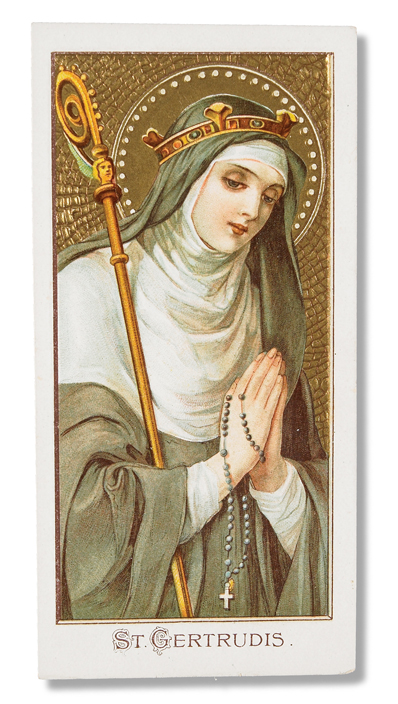
BENEDICT XVI GENERAL AUDIENCE (the entire text translated in English) from vatican.va
Dear Brothers and Sisters,
St Gertrude the Great, of whom I would like to talk to you today, brings us once again this week to the Monastery of Helfta, where several of the Latin-German masterpieces of religious literature were written by women. Gertrude belonged to this world. She is one of the most famous mystics, the only German woman to be called “Great”, because of her cultural and evangelical stature: her life and her thought had a unique impact on Christian spirituality. She was an exceptional woman, endowed with special natural talents and extraordinary gifts of grace, the most profound humility and ardent zeal for her neighbour’s salvation. She was in close communion with God both in contemplation and in her readiness to go to the help of those in need.
At Helfta, she measured herself systematically, so to speak, with her teacher, Matilda of Hackeborn, of whom I spoke at last Wednesday’s Audience. Gertrude came into contact with Matilda of Magdeburg, another medieval mystic and grew up under the wing of Abbess Gertrude, motherly, gentle and demanding. From these three sisters she drew precious experience and wisdom; she worked them into a synthesis of her own, continuing on her religious journey with boundless trust in the Lord. Gertrude expressed the riches of her spirituality not only in her monastic world, but also and above all in the biblical, liturgical, Patristic and Benedictine contexts, with a highly personal hallmark and great skill in communicating.
Gertrude was born on 6 January 1256, on the Feast of the Epiphany, but nothing is known of her parents nor of the place of her birth. Gertrude wrote that the L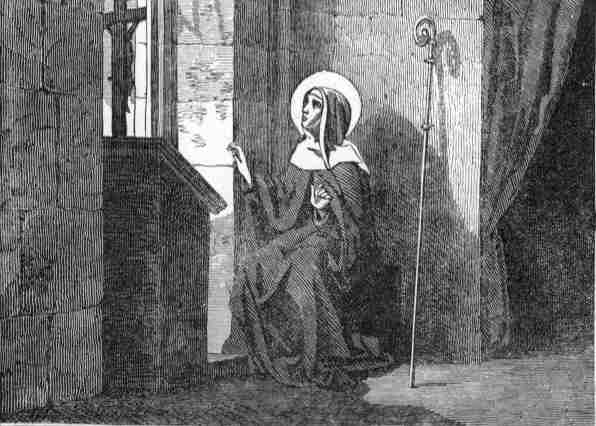 ord himself revealed to her the meaning of this first uprooting: “I have chosen you for my abode because I am pleased that all that is lovable in you is my work…. For this very reason I have distanced you from all your relatives, so that no one may love you for reasons of kinship and that I may be the sole cause of the affection you receive” (The Revelations, I, 16, Siena 1994, pp. 76-77).
ord himself revealed to her the meaning of this first uprooting: “I have chosen you for my abode because I am pleased that all that is lovable in you is my work…. For this very reason I have distanced you from all your relatives, so that no one may love you for reasons of kinship and that I may be the sole cause of the affection you receive” (The Revelations, I, 16, Siena 1994, pp. 76-77).
When she was five years old, in 1261, she entered the monastery for formation and education, a common practice in that period. Here she spent her whole life, the most important stages of which she herself points out. In her memoirs she recalls that the Lord equipped her in advance with forbearing patience and infinite mercy, forgetting the years of her childhood, adolescence and youth, which she spent, she wrote, “in such mental blindness that I would have been capable… of thinking, saying or doing without remorse everything I liked and wherever I could, had you not armed me in advance, with an inherent horror of evil and a natural inclination for good and with the external vigilance of others. “I would have behaved like a pagan… in spite of desiring you since childhood, that is since my fifth year of age, when I went to live in the Benedictine shrine of religion to be educated among your most devout friends” (ibid., II, 23, p. 140f.).
Gertrude was an extraordinary student, she learned everything that can be learned of the sciences of the trivium and quadrivium, the education of that time; she was fascinated by knowledge and threw herself into profane studies with zeal and tenacity, achieving scholastic successes beyond every expectation. If we know nothing of her origins, she herself tells us about her youthful passions: literature, music and song and the art of miniature painting captivated her. She had a strong, 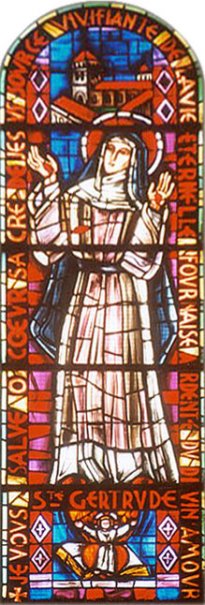 determined, ready and impulsive temperament. She often says that she was negligent; she recognizes her shortcomings and humbly asks forgiveness for them. She also humbly asks for advice and prayers for her conversion. Some features of her temperament and faults were to accompany her to the end of her life, so as to amaze certain people who wondered why the Lord had favoured her with such a special love.
determined, ready and impulsive temperament. She often says that she was negligent; she recognizes her shortcomings and humbly asks forgiveness for them. She also humbly asks for advice and prayers for her conversion. Some features of her temperament and faults were to accompany her to the end of her life, so as to amaze certain people who wondered why the Lord had favoured her with such a special love.
From being a student she moved on to dedicate herself totally to God in monastic life, and for 20 years nothing exceptional occurred: study and prayer were her main activities. Because of her gifts she shone out among the sisters; she was tenacious in consolidating her culture in various fields.
Nevertheless during Advent of 1280 she began to feel disgusted with all this and realized the vanity of it all. On 27 January 1281, a few days before the Feast of the Purification of the Virgin, towards the hour of Compline in the evening, the Lord with his illumination dispelled her deep anxiety. With gentle sweetness he calmed the distress that anguished her, a torment that Gertrude saw even as a gift of God, “to pull down that tower of vanity and curiosity which, although I had both the name and habit of a nun alas I had continued to build with my pride, so that at least in this manner I might find the way for you to show me your salvation” (ibid., II, p. 87). She had a vision of a young man who, in order to guide her through the tangle of thorns that surrounded her soul, took her by the hand. In that hand Gertrude recognized “the precious traces of the wounds that abrogated all the acts of accusation of our enemies” (ibid., II, 1, p. 89), and thus recognized the One who saved us with his Blood on the Cross: Jesus.
From that moment her life of intimate communion with the Lord was intensified, especially in the most important liturgical seasons Advent-Christmas, Lent-Easter, the feasts of Our Lady even when illness prevented her from going to the choir. This was the same liturgical humus as that of Matilda, her teacher; but Gertrude describes it with simpler, more linear images, symbols and terms that are more realistic and her references to the Bible, to the Fathers and to the Benedictine world are more direct.
Her biographer points out two directions of what we might describe as her own particular “conversion“: in study, with the radical passage from profane, humanistic studies to the study of theology, and in monastic observance, with the passage from a life that she describes as negligent, to the life of intense, mystical prayer, with exceptional missionary zeal. The Lord who had chosen her from her mother’s womb and who since her childhood had made her partake of the banquet of monastic life, called her again with his grace “from external things to inner life and from earthly occupations to love for spiritual things”. Gertrude understood that she was remote from him, in the region of unlikeness, as she said with Augustine; that she had dedicated herself with excessive greed to liberal studies, to human wisdom, overlooking spiritual knowledge, depriving herself of the taste for true wisdom; she was then led to the mountain of contemplation where she cast off her former self to be reclothed in the new. “From a grammarian she became a theologian, with the unflagging and attentive reading of all the sacred books that she could lay her hands on or contrive to obtain. She filled her heart with the most useful and sweet sayings of Sacred Scripture. Thus she was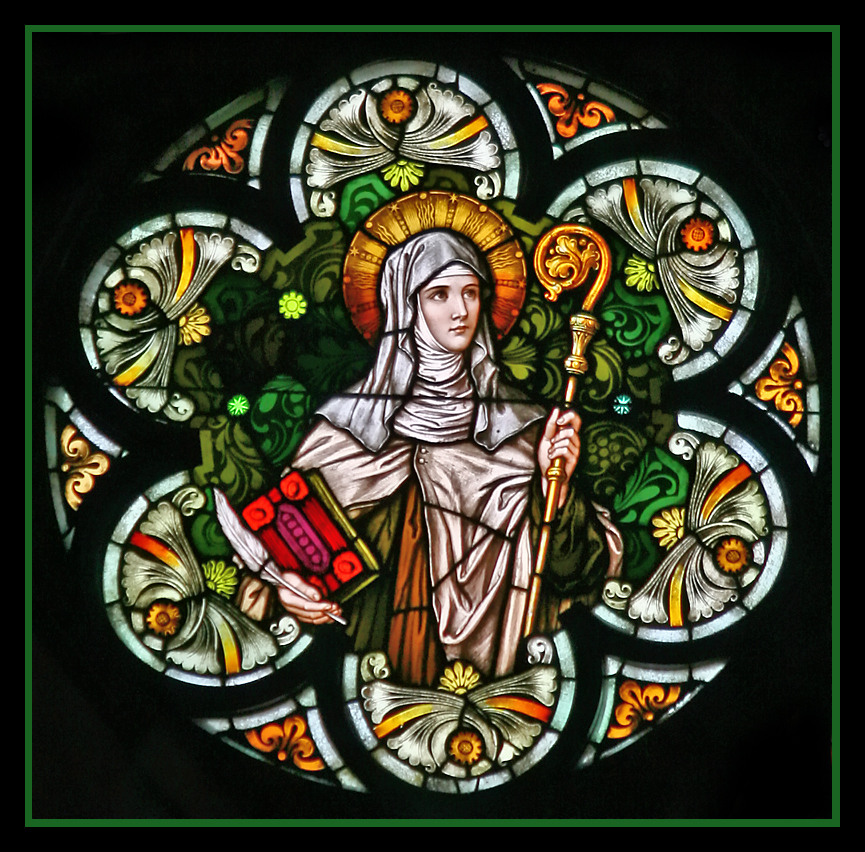 always ready with some inspired and edifying word to satisfy those who came to consult her while having at her fingertips the most suitable scriptural texts to refute any erroneous opinion and silence her opponents” (ibid., I, 1, p. 25).
always ready with some inspired and edifying word to satisfy those who came to consult her while having at her fingertips the most suitable scriptural texts to refute any erroneous opinion and silence her opponents” (ibid., I, 1, p. 25).
Gertrude transformed all this into an apostolate: she devoted herself to writing and popularizing the truth of faith with clarity and simplicity, with grace and persuasion, serving the Church faithfully and lovingly so as to be helpful to and appreciated by theologians and devout people.
Little of her intense activity has come down to us, partly because of the events that led to the destruction of the Monastery of Helfta. In addition to The Herald of Divine Love and The Revelations, we still have her Spiritual Exercises, a rare jewel of mystical spiritual literature.
In religious observance our Saint was “a firm pillar… a very powerful champion of justice and truth” (ibid., I, 1, p. 26), her biographer says. By her words and example she kindled great fervour in other people. She added to the prayers and penances of the monastic rule others with such devotion and such trusting abandonment in God that she inspired in those who met her an awareness of being in the Lord’s presence. In fact, God made her understand that he had called her to be an instrument of his grace. Gertrude herself felt unworthy of this immense divine treasure, and confesses that she had not safeguarded it or made enough of it. She exclaimed: “Alas! If you had given me to remember you, unworthy as I am, by even only a straw, I would have viewed it with greater respect and reverence that I have had for all your gifts!” (ibid., II, 5, p. 100). Yet, in recognizing her poverty and worthlessness she adhered to God’s will, “because”, she said, “I have so little profited from your graces that I cannot resolve to believe that they were lavished upon me solely for my own use, since no one can thwart your eternal wisdom. Therefore, O Giver of every good thing who has freely lavished upon me gifts so undeserved, in order that, in reading this, the heart of at least one of your friends may be moved at the thought that zeal for souls has induced you to leave such a priceless gem for so long in the abominable mud of my heart” (ibid., II, 5, p. 100f.).
Two favours in particular were dearer to her than any other, as Gertrude herself writes: “The stigmata of your salvation-bearing wounds which you impressed upon me, as it were, like a valuable necklaces, in my heart, and the profound and salutary wound of love with which you marked it. “You flooded me with your gifts, of such beatitude that even were I to live for 1,000 years with no consolation neither interior nor exterior the memory of them would suffice to comfort me, to enlighten me, to fill me with gratitude. 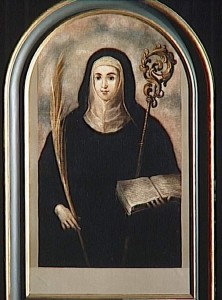 Further, you wished to introduce me into the inestimable intimacy of your friendship by opening to me in various ways that most noble sacrarium of your Divine Being which is your Divine Heart…. To this accumulation of benefits you added that of giving me as Advocate the Most Holy Virgin Mary, your Mother, and often recommended me to her affection, just as the most faithful of bridegrooms would recommend his beloved bride to his own mother” (ibid., II, 23, p. 145).
Further, you wished to introduce me into the inestimable intimacy of your friendship by opening to me in various ways that most noble sacrarium of your Divine Being which is your Divine Heart…. To this accumulation of benefits you added that of giving me as Advocate the Most Holy Virgin Mary, your Mother, and often recommended me to her affection, just as the most faithful of bridegrooms would recommend his beloved bride to his own mother” (ibid., II, 23, p. 145).
Looking forward to never-ending communion, she ended her earthly life on 17 November 1301 or 1302, at the age of about 46. In the seventh Exercise, that of preparation for death, St Gertrude wrote: “O Jesus, you who are immensely dear to me, be with me always, so that my heart may stay with you and that your love may endure with me with no possibility of division; and bless my passing, so that my spirit, freed from the bonds of the flesh, may immediately find rest in you. Amen” (Spiritual Exercises, Milan 2006, p. 148).
It seems obvious to me that these are not only things of the past, of history; rather St Gertrude’s life lives on as a lesson of Christian life, of an upright path, and shows us that the heart of a happy life, of a true life, is friendship with the Lord Jesus. And this friendship is learned in love for Sacred Scripture, in love for the Liturgy, in profound faith, in love for Mary, so as to be ever more truly acquainted with God himself and hence with true happiness, which is the goal of our life. Many thanks.
Tags: benedict xvi, catholic, catholic podcast, catholic prayer, cathollc spirituality, contemplation, famous mystics, heart, love, mystic, mystic of the Church, mystical experiences, sacred scripture, st gertrude, truth, women of the middle ages
This entry was posted on Wednesday, October 6th, 2010 at 6:47 pm
You can follow any responses to this entry through the RSS 2.0 feed.

